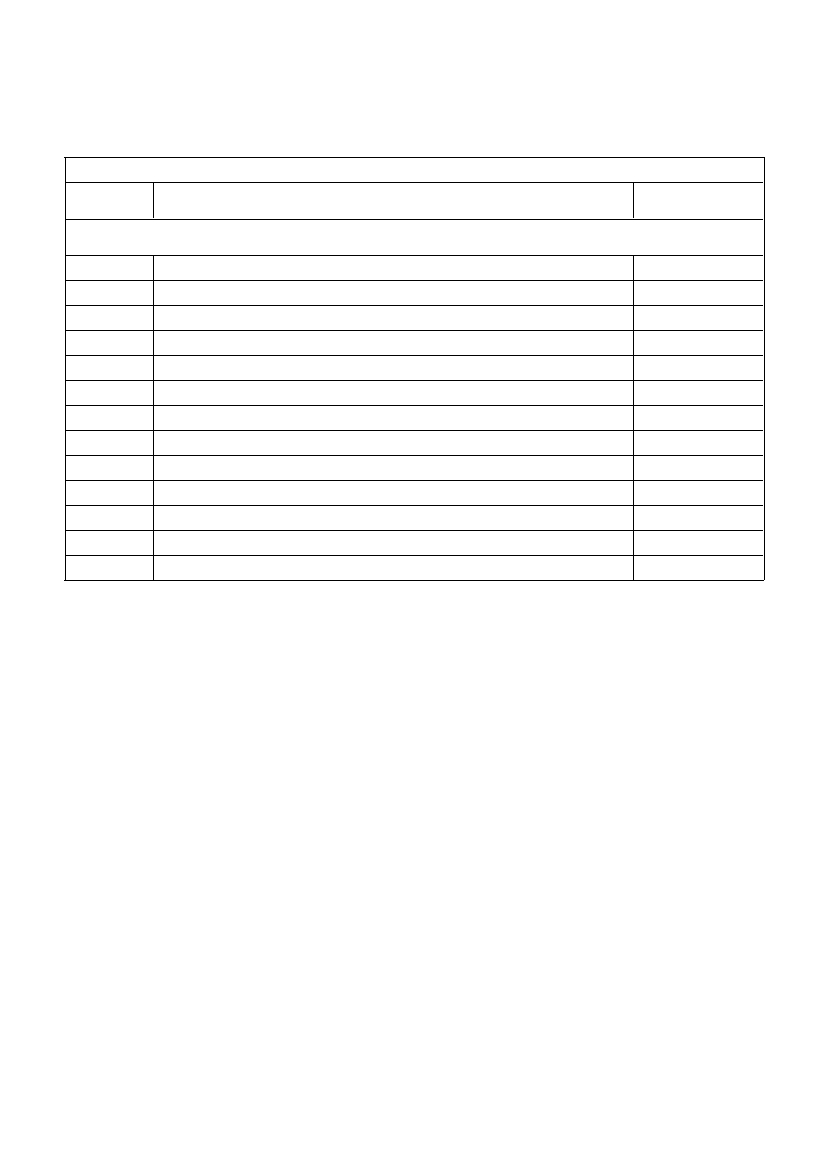
Department of Computer Science and Engineering
Affiliated Engineering College
University of Dhaka
Syllabus for B.Sc. in Computer Science and
Engineering
Session: 2019-20
Semester I
Course Code Course Title
Prerequisites
Credit
Hours
Theory
Courses
CSE-1101
Fundamentals of Computers and Computing
2.0
CSE-1102
Discrete Mathematics
3.0
EEE-1103
Electrical Circuits
3.0
CHE-1104
Chemistry
3.0
MATH-1105 Differential and Integral Calculus
3.0
SS-1106
Government and Public Administration
2.0
Lab Courses
CSE-1111
Fundamentals of Computers and Computing Lab
1.5
EEE-1113
Electrical Circuits Lab
1.5
CHE-1114
Chemistry Lab
1.5
Total Credits in 1st
20.50
Semester
Semester II
Course
Course Title
Prerequisites
Credit
Code
Hours
Theory
Course
CSE-1201
Fundamentals of Programming
CSE-1101, CSE-
3.0
1102
CSE-1202
Digital Logic Design
3.0
PHY-1203
Physics
3.0
MATH-1204 Methods of Integration, Differential Equations and Series
MATH-1105
3.0
ENG-1205
Developing English Language Skills
2.0
Lab Course
CSE-1211
Fundamentals of Programming Lab
CSE-1111
3.0
CSE-1212
Digital Logic Design Lab
1.5
PHY-1213
Physics Lab
1.5
ENG-1215
Developing English Language Skills Lab
1.5
Total Credits in
21.50
2 nd Semester

S emester III
Course Code
Course
Prerequisites
Credit
Title
Hours
Theory
Courses
CSE-2101
Data Structures and Algorithms
CSE-1201
3.0
CSE-2102
Object Oriented Programming
CSE-1201
3.0
CSE-2103
Digital Electronics and Pulse Technique
CSE-1202
3.0
EEE-2104
Electronic Devices and Circuits
CSE-1202
3.0
MATH-2105 Linear Algebra
MATH-1204
3.0
SS-2106
Bangladesh Studies
2.0
Lab Courses
CSE-2111
Data Structures and Algorithms Lab
CSE-1211
1.5
CSE-2112
Object Oriented Programming Lab
CSE-1211
1.5
CSE-2113
Digital Electronics and Pulse Technique
CSE-1212
1.5
EEE-2114
Electronic Devices and Circuits Lab
CSE-1212
0.75
Total Credits in 3rd
22.25
Semester
S emester IV
Course Code
Course
Prerequisites
Credit
Title
Hours
Theory
Courses
CSE-2201
Database Management Systems-I
CSE-2101
3.0
CSE-2202
Design and Analysis of Algorithms-I
CSE-2101
3.0
CSE-2203
Data and Telecommunication
CSE-2101
3.0
CSE-2204
Computer Architecture and Organization
CSE-1202
3.0
CSE-2205
Introduction to Mechatronics
EEE-1103, CSE-
2.0
1202
Lab Courses
CSE-2211
Database Management Systems - I Lab
CSE-2111
1.5
CSE-2212
Design and Analysis of Algorithms - I Lab
CSE-2111
1.5
CSE-2213
Data and Telecommunication Lab
CSE-2111
0.75
CSE-2216
Application Development Lab
CSE-2101, CSE-
1.5
2102, CSE-2111,
CSE-2112
Total Credits in 4 th Semester
19.25

Semester V
Course Code
Course
Prerequisites
Credit
Title
Hours
Theory Courses
CSE-3101
Computer Networking
CSE-2203
3.0
CSE-3102
Software Engineering
CSE-2101,
3.0
CSE2102
CSE-3103
Microprocessor and Microcontroller
CSE-2204
3.0
CSE-3104
Database Management Systems -II
CSE-2201
3.0
MATH-3105
Multivariable Calculus and Geometry
MATH-2105
3.0
Lab Courses
CSE-3111
Computer Networking Lab
CSE-2213
1.5
CSE-3112
Software Engineering Lab
CSE-2111, CSE-
0.75
2112
CSE-3113
Microprocessor and Assembly Language Lab
1.5
CSE-3116
Microcontroller Lab
0.75
Total Credits in 5 th
19.50
Semester
Semester VI
Course Code
Course Title
Prerequisites
Credit
Hours
Theory
Courses
CSE-3201
Operating Systems
CSE-2202, CSE-
3.0
2204
CSE-3202
Numerical Methods
CSE-2202
3.0
CSE-3203
Design and Analysis of Algorithms - II
CSE-2202
3.0
CSE-3204
Formal Language, Automata and Computability
CSE-1102
3.0
STAT-3205
Introduction to Probability and Statistics
3.0
Lab Courses
CSE-3211
Operating Systems Lab
CSE-2212
1.5
CSE-3212
Numerical Methods Lab
CSE-2212
0.75
CSE-3216
Software Design Patterns Lab
CSE-3112
1.5
ENG-3217
Technical Writing and Presentation Lab
ENG-1215
0.75
Total Credits in 6 th
19.50
Semester

Semester VII
Course Code
Course Title
Prerequisites
Credit
Hours
Theory Course
CSE-4101
Artificial Intelligence
CSE-2202
3.0
MATH-
CSE-4102
Mathematical and Statistical Analysis for Engineers
2105
3.0
MATH-
3105
STAT-3205
SS-4103
Entrepreneurship for IT Business
2.0
CSE-4XXX
Option-I
3.0
CSE-4XXX
Option-II
3.0
Lab Courses
CSE-4111
Artificial Intelligence Lab
CSE-2212
1.5
CSE-4XXX
Option-I Lab
1.5
CSE-4113
Internet Programming Lab
CSE-2216
1.5
CSE-4114
Project
2.0
Total Credits in 7 th
20.50
Semester
Semester VIII
Course Code
Course Title
Prerequisites
Credit
Hours
Theory
Courses
ECO-4201
Economics
2.0
CSE-4202
Society and Technology
2.0
SS-4203
Engineering Ethics
2.0
CSE-4XXX
Option-III
3.0
CSE-4XXX
Option-IV
3.0
Lab Courses
CSE-4XXX
Option-III Lab
1.5
CSE-4214
Project
CSE-4114
4.0
Total Credits in 8 th
17.50
Semester
Summary of Eight
Semesters
1st Semester (1 st Year 1 st Semester)
20.50
2nd Semester (1 st Year 2 nd Semester)
21.50
3rd Semester (2 nd Year 1 st Semester)
22.25
4th Semester (2 nd Year 2 nd Semester)
19.25
5th Semester (3 rd Year 1 st Semester)
19.50
6th Semester (3 rd Year 2 nd Semester)
19.50
7th Semester (4 th Year 1 st Semester)
20.50
8th Semester (4 th Year 2 nd Semester)
17.50
Total Credits in Eight
160.50
Semesters:

Option - I
Course Code Course Title
Credit
Hours
Theory
Courses
CSE-4121
Robotics Science and Systems
3.0
CSE-4123
Computational Methods in Bio-molecular Sequence & Structure Analysis
3.0
CSE-4125
Introduction to Machine Learning
3.0
CSE-4127
Information Retrieval
3.0
CSE-4131
Introduction to VLSI Design
3.0
CSE-4133
Algorithm Engineering
3.0
CSE-4135
Software Requirements Specification and Analysis
3.0
CSE-4137
Cryptography and Security
3.0
CSE-4139
Computer Graphics
3.0
Lab Courses
CSE-4151
Robotics Science and Systems Lab
1.5
CSE-4153
Computational Methods in Bio-molecular Sequence & Structure Analysis Lab
1.5
CSE-4155
Introduction to Machine Learning Lab
1.5
CSE-4157
Information Retrieval Lab
1.5
CSE-4161
Introduction to VLSI Design Lab
1.5
CSE-4163
Algorithm Engineering Lab
1.5
CSE-4165
Software Requirements Specification and Analysis Lab
1.5
CSE-4167
Cryptography and Security Lab
1.5
CSE-4169
Computer Graphics Lab
1.5

Option - II
Course Code Course Title
Credit
Hours
Theory
Courses
CSE-4122
Mathematics for Robotics
3.0
CSE-4124
Introduction to Bioinformatics
3.0
CSE-4126
Introduction to Data Science
3.0
CSE-4128
Wireless Networks
3.0
CSE-4130
Introduction to Quantum Logic
3.0
CSE-4132
Graph Theory
3.0
CSE-4134
Software Project Management
3.0
CSE-4136
Computer Security
3.0
CSE-4140
Compiler Design
3.0

Option - III
Course Code Course Title
Credit
Hours
Theory
Courses
CSE-4221
Robot Learning
3.0
CSE-4223
Fundamentals of Genomics and Proteomics
3.0
CSE-4225
Introduction to Data Mining and Warehousing
3.0
CSE-4227
Cloud Computing
3.0
CSE-4229
Introduction to Reversible Computing
3.0
CSE-4231
Computational Geometry
3.0
CSE-4233
Software Testing and Verification
3.0
CSE-4235
Digital Forensic
3.0
CSE-4237
Digital Image Processing
3.0
CSE-4239
Parallel and Distributed Systems
3.0
Lab Courses
CSE-4251
Robot Learning Lab
1.5
CSE-4253
Fundamentals of Genomics and ProteomicsLab
1.5
CSE-4255
Introduction to Data Mining and Warehousing Lab
1.5
CSE-4257
Cloud Computing Lab
1.5
CSE-4259
Introduction to Reversible Computing Lab
1.5
CSE-4261
Computational Geometry Lab
1.5
CSE-4263
Software Testing and Verification Lab
1.5
CSE-4265
Digital Forensic Lab
1.5
CSE-4267
Digital Image Processing Lab
1.5
CSE-4269
Parallel and Distributed Systems Lab
1.5

Option - IV
Course Code Course Title
Credit
Hours
Theory
Courses
CSE-4222
Human Robot Interaction
3.0
CSE-4224
Mobile Robotics
3.0
CSE-4226
Aerial Robotics
3.0
CSE-4228
Application of Computational Biology
3.0
CSE-4230
Human Computer Interaction
3.0
CSE-4232
Internet of Things
3.0
CSE-4234
Introduction to Multiple-Valued Logic
3.0
CSE-4236
VLSI Layout Algorithms
3.0
CSE-4238
Concepts of Concurrent Computation
3.0
CSE-4240
Applied Cryptography
3.0
CSE-4242
Computer Vision
3.0
CSE-4244
Computer and Network Security
3.0
CSE-4246
Natural Language Processing
3.0

Semester I (1 st year 1
st
CSE-1101: Fundamentals of Computers and Computing [2.0 credits,
30 hours lecture]
(Pre-requisite Courses: None)
Introduction to Computers: From a Key Press to Display, Hardware, Software, Operating System,
Microprocessor, Memory Overview, File and File System. Input-Output Devices . Application
Software: Basic Text Editor (gedit, Notepad), Document Processing, Spreadsheet, Presentation,
Database, Mathematical Analysis, Simulation, Image and Video Editing, Games etc. Network and
Internet: Networking Concept and Topologies, Network Addresses (MAC, IP and Port), Name vs.
IP (role of DNS). Browser Software: Examples, URL, Security, Email, Email Address, Email -
Client Software, Email Software in the Internet, Network Configuration and Basic Tools (ping,
traceroute etc.). Number System: Concept of Bit, Electronic Representation of Bits. Bit- Array:
Byte, Word, Double Word. Binary
Hexadecimal Arithmetic up to 32- Bit Array Representation.Conversion between Binary,
Hexadecimal and Octal Numbers. Representation of Characters by Bit- Array: ASCII and UTF-8.
Character Arithmetic: Case and Language Mapping and Changing. Memory: Introduction to
Computer Memory .System Modeling and Flow Chart.Introduction to Programming: Program
Structure, Variables, Constants, I/O, Conditional Statements (If- Else), More about Conditional
Statements (Nested If).
CSE-1102:Discrete Mathematics [3.0
credits, 45 hours lecture] (Pre-requisite
Courses: None)
Logics and Proofs: Propositional Logic, Applications of Propositional Logic, Propositional
Equivalences, Predicates and Quantifiers, Nested Quantifiers, Rules of Inference, Introduction to
Proofs. Set, Function, Sequence, Summation and Matrix: Sets, Set Operations, Functions,
Sequences and Summations, Zero – One Matrices, Boolean Product. Number Theory: Divisibility
and Modular Arithmetic, Integer Representations and Algorithms, Primes and Greatest Common
Divisors, Modular Exponentiation. Induction: Mathematical Induction. Counting: The Basics of
Counting, the Pigeonhole Principle, Permutations and Combinations, Binomial Coefficients and
Identities, Generalized Permutations and Combinations. Recursion: Applications of Recurrence
Relations.

Inclusion Exclusion: Inclusion – Exclusion. Relations: Relations and Their Properties,
Representing Relations. Graphs: Graphs and Graph Models, Graph Terminology and Special Types
of Graph, Euler and Hamilton Paths. Trees: Introduction to Trees.
EEE-1103: Electrical Circuits [3.0
credits, 45 hours lecture] (Pre-requisite
Courses: None)
Resistor : Properties, Types of Resistors, Ohm’s Law, Power, Energy, Efficiency, etc. Series DC
Circuits: Kirchhoff’s Voltage Law, Voltage Divider Rule, Power Distribution, Voltage Regulation,
Voltage Sources in Series, etc. Parallel DC Circuits: Conductance and Resistance, Kirchhoff’s
Current Law, Current Divider Rule, Open Circuit, Short Circuit, Voltage Sources in Parallel, etc. DC
Series
- Parallel Network: Reduce and Return Approach, Block Diagram Approach, Ladder Networks.
Methods of Analysis for DC Networks: Current Source, Source Conversion, Current Sources in
Series and Parallel, Branch- Current Analysis, Mesh Analysis, Nodal Analysis, Bridge Network and
� and � Conversions. Network Theorems (DC): Superposition, Thevenin’s, Norton’s,
Maximum Power Transfer, Millman’s, Substitution, Reciprocity, etc. Capacitor: Electric Field,
Capacitance, Dielectric Strength, Leakage Current, Types of Capacitors, Charging and Discharging
Phase, Energy Stored by a Capacitor, Capacitors in Series and Parallel. Inductor: Magnetic Field,
Inductance, Types of Inductors, Faraday’s Law and Lenz’s Law, Inductors in Series and Parallel. R-
L, R-C and R-L-C Circuits with DC Input. Introduction to Sinusoidal Alternating Waveforms:
Definitions, General Format for the Sinusoidal Voltage or Current, Phase Relations, Average and
RMS Values etc. Ordinary and Frequency Response of Basic R, L and C Elements, Average Power
and Power Factor, Rectangular and Polar Form, Phasors.
CHE-1104: Chemistry [3.0 credits, 45
hours lecture] (Pre-requisite Courses:
None)
Atomic Structure: Bohr Atomic Model, Limitations of Bohr’s Model, Atomic Spectra, Wave Nature
of Electron, Heisenberg Uncertainty Principle, Schrodinger Equation, Quantum Numbers, Pauli’s
Exclusion Principle, Aufbau Principle, Hund’s Rule, Electronic Configuration. Periodic Table: s, p,
d and f- Block Elements, Periodic Law, Atomic Radii, Ionization Potential, Electronegativity,
Electron Affinity, Diagonal Relationship, Metals, Metalloids, Nonmetals and Their Properties,
Properties and Uses of Noble Gases. Chemical Bonding: Reason of Chemical Bonding, Ionic Bond,
Covalent Bond, Coordinate Covalent Bond, Hydrogen Bond, Metallic Bond, Vander Waal’s Force.
Oxidation Reduction: Charge Concept, Electronic Concept, Oxidizing Agent, Reducing Agent,
Oxidation Number, Balancing the Oxidation Reduction Equation. Acid Base: Bronsted Concept,
Lewis Concept, Ionization

of Water, pH, Neutralization Curve, Indicators and Their Selection, Buffer, Henderson Equation.
State of Matter: Gas Laws: Boyle’s Law, Charles’ Law, Avogadro’s Law, Ideal Gas, Real Gas, Ideal
Gas Equation and Its Limitation, Vander Waal’s Equation, Kinetic Theory of Gases. Phase Rule:
Definitions, Phase Rule of Water and Carbon Dioxide. Thermodynamics: First Law, Work Done
for Expansion of Gases, Thermochemistry, Second Law, Carnot Cycle, Third Law. Chemical
Kinetics: Rate Law, Rate Equation, Molecularity and Order of a Reaction, Derivation of Rate –
Expression and Half- Life for First Order and Second Order Reactions, Pseudo First Order Reaction.
Chemical Equilibrium: Dynamic Behavior of Chemical E quilibrium, Law of Mass Action,
Equilibrium Constant, Le Chatelier Principle and Its Application. Solution : Different Solutions,
Colligative Properties. Electrochemistry: Electrolysis, Electrolytes, Electrolytic Cell, Faraday’s
Law, Electrochemical Cells, Electrode Potential, Standard Electrode and Standard Electrode
Potential, Nernst Equation and Its Application. Biomolecules : Carbohydrates, Proteins, Nucleic
Acid, Polymers and Polymerization Processes.
MATH-1105: Differential and Integral Calculus
[3.0 credits, 45 hours lecture] Pre-requisite
Courses: None)
Functions: Graphing Functions, Mathematical Models and Commonly used Functions (Linear,
Polynomial, Power), Mathematical Models and Commonly Used Functions (Algebraic,
Trigonometric, Exponential, and Logarithmic Functions), Transformations (Scaling, Reflection,
Composition), Inverse of Functions, Growth of Functions. Limits: Concepts, One Sided Limits,
Infinite limits, Limit Laws, Sandwich Theorem, Formal Definition of Limits and Continuity of
Functions, Intermediate Value Theorem and Its Application, Limits at Infinity and the Horizontal
Asymptotes. Derivatives: Derivatives and Rate of Change, Derivatives as Functions,
Differentiability of Functions, Rules and Techniques of Differentiation. Applications of
Differentiation: Rates of Change in Natural and Social Sciences, Exponential Growth and Decay,
Linear Approximation and Differentials, Finding Minimum and Maximum Value of Functions and
the first and Second Derivative Tests, Indeterminate Forms and L'Hospital's Rule, Curve Sketching.
Integrals: Riemann Sum and Definite Integrals, Properties of Integrals, Fundamental Theorem of
Calculus, Anti-Derivative and Indefinite Integral, Net Change Theorem, Substitution Rule.
Application of Integration: Finding Area between Curves, Volumes, Volumes by Cylindrical
Shells, Average Value of a Function, Mean Value Theorem for Integrals.

SS-1106: Government and Public Administration
[2.0 credits, 30 hours lecture] Pre-requisite
Courses: None)
Constitution of Bangladesh, fundamental rights as enunciated in Bangladesh constitution, forms of
government of Bangladesh, organs of government : a) legislative assembly: composition, powers and
functions, b) judiciary- composition, powers and functions, c) executive public administration, role
of government, good governance, accountability and transparency of the public servant, local
government, human resource management and planning.
CSE-1111: Fundamentals of Computers and Computing
Lab [1.5 Credits, 45 Hours Lab] (Pre-requisite Courses:
None)
Contents related to the coursework CSE-1101 (Fundamentals of Computers and Computing).
EEE-1113: Electrical Circuits Lab [1.5
Credits, 45 Hours Lab](Pre- requisite
Courses: None)
Contents related to the coursework EEE-1103 (Fundamentals of Electricals and Electronics).
CHE-1114: Chemistry Lab [1.5 Credits,
45 Hours Lab] (Pre-requisite Courses:
None)
Contents related to the coursework CHE-1104 (Chemistry).

Semester II (1 st Year 2
nd
CSE-1201: Fundamentals of Programming[3.0 credits, 45
hours lecture] (Pre-requisite Courses: CSE-1101, CSE-1102)
Review of Basics: Basic I/O, Data Type, Conditional Logic, Switch Case, Character, ASCII Value,
Reading and Writing Character, Integer to Character Conversion. Operators: Arithmetic, Relational,
Logical and Bitwise Operators, Operator Precedence and Associativity, Arithmetic Expression
Evaluation, Short Cut Operator. Functions–I: Basic Functions, Void Functions with No Parameters.
Loops: Looping Basic, Necessity of Loops, While Loop, Loop Condition, Body, Initialization,
Increment, For Loops, Part of For Loops, Do While Loop, Entry Controlled Loops, Exit Controlled
Loops, Example, Formulating Problems Using Loops. Formatted I/O: Specifying Width using
Format Specifier in printf and scanf in Details. Nested Loop: Nesting of Two Loops, Example,
Nesting of Independent Loops inside One, Example, Nesting of More Than Two Loops. Functions
Library Functions/Header Files Concept. Arrays: Basics of Array, Necessity, Declaration, Accessing
through Indices, Accessing using Loops, Initialization, Example, Two Dimensional Arrays,
Declaration, Initialization, Accessing through Loops, Example, Multidimensional Arrays, Example.
Functions – III: Passing Arrays in a Function as Parameter, Call by Reference, Recursion, Scope
Visibility and Lifetime of Variable. Strings: Basics, Difference between String and Character Array,
I/O, Basic Operations without using Library Functions, Array of Strings. String Library: Basic
String
Operations,
Length,
Compare,
Concatenate,
Substring,
Reverse.
Structures: Basics,
Necessity, Declaration,
Accessing,
Initialization, Array of structures. Pointers: Basics, Uses, Pointer Operation, Call by Reference using
Pointers, Pointer for 1D/2D/3D Array, Structure, Pointer Expression, Array of Pointers, Function
Returning Pointers. Dynamic Memory Allocation: Basics, Uses, Malloc, Free, Calloc, Realloc. File
Operation: Basics, Uses, File Opening, Closing, File I/O, Use of Redirect Operator to Write in File
or Read from File. Preprocessors and Macros .

CSE-1202: Digital Logic Design [3.0
credits, 45 hours lecture] (Pre-requisite
Courses: None)
Introduction: Introductory Concepts, Binary, Octal and Hexadecimal Number System BCD, ASCH
and EBCDIC Codes, Combinatorial Logic: Data Representation Logic Gates and Boolean Algebra,
Combinational Circuits Design using NAND of NOR Gates Only. Introduction to Decision Diagram,
Minimization of Switching Functions Algebraic Simplification, Karnaugh Map, VEKM,
QuinceMcCluskey Method. Sequential Logic: NAND and NOR Latches. Clocked SR. JK D and T
Flip - Flops. FF Timing Consideration. Master- Slave FF. Complex Sequential logic: Frequency
Division and Counting Troubleshooting Case Studies. Asynchronous Ripple Up and Down Counters,
Counters with Any MOD Numbers Asynchronous IC Counters, Propagation Delay. Parallel Up
Down and Up/Down Counters. Presentable Counters.The 74193 Counter.Decoding a
Counter.Cascading Counters. Shift Registers, IC Shift Digital Clock. MSI Logic Circuits: BCD – to
- Decimal Decoders, BCD – to- 7 Segment Decoder/Drivers. Encoders. Multiplexer and De-
multiplexer. Integrated Circuits Logic Families: TTL Logic Family Standard TTL Series
Characteristics, Other TTL Series TTL Loading Rules, Digital MOSFET Circuits. Memory Devices:
Semiconductor Memory Technologies ROM Architecture Timing and Type of ROM, EPROM,
EEPROM, ROM Applications. RAM Architecture Static and Dynamic RAM, DRAM Structure
Operation and Refreshing.Introduction to Sequential Circuits, Formal Representation of Sequential
Circuits. Arithmetic circuits: The Half- Adder Full Adder. Parallel Adders.
PHY-1203: Physics [3.0
credits, 45 hours lecture] (Pre-
requisite Courses: None)
Heat and Thermodynamics: Introductory Concepts and Zeroth Law, Energy Considerations, Work
and Heat, Units, Thermodynamic Process, Properties and Equilibrium, First Law of Thermodynamics
and It’s Applications, Reversible and Irreversible Processes, Second Law of Thermodynamics,
Carnot Cycle, Efficiency of Heat Engines and Heat Pump, Carnot’s Theorem, Absolute Scale of
Temperature, Entropy. Structure of Matter : Crystalline & Non- Crystalline Solids, Single Crystal
and Polycrystal Solids, Unit Cell, Crystal Systems, Co-ordinations Number, Crystal Planes and
Directions, Packing Factor, Miller Indices, Bragg’s Law, Defects in Solids, Point Defects, Line
Defects, Bonds in Solids, Interatomic Distances, Introduction to Band Theory, Distinction between
Metal, Semiconductor and Insulator. Waves and Oscillations: Differential Equation of a Simple
Harmonic Oscillator, Total Energy and Average Energy, Combination of Simple Harmonic
Oscillations, Issajous’ Figures, Spring- Mass System,

Damped Oscillation, Forced Oscillation, Resonance, Two- Body Oscillations, Reduced Mass,
Differential Equation of a Progressive Wave, Power and Intensity of Wave Motion, Stationary Wave,
Group Velocity and Phase Velocity, Architectural Acoustics, Reverberation and Sabine’s Formula.
Physical Optics: Theories of Light, Interference of Light, Young’s Double Slit Experiment,
Displacements of Fringes and Its Uses, Fresnel Bi- Prism, Newton’s Rings, Interferometers,
Diffraction of Light, Fresnel and Fraunhoffer Diffraction, Resolving Power of Optical Instruments,
Diffraction at Double Slit & N – Slits, Diffraction Grating, Polarization, Production and Analysis of
Polarized Light.
MATH-1204: Methods of Integration, Differential Equations
and Series [3.0 credits, 45 hours lecture](Pre-requisite
Courses: MATH-1105)
Techniques of Integration: Integration by Parts, Trigonometric Substitution, Partial Fractions,
Computer Algebra Systems (e.g. Mathematica, Sage), Approximate Integration - Simpson's Rule ,
Improper Integrals . Application of Integration: Arc Length, Area of a Surface of Revolution.
Differential Equations: Modeling with Differential Equations, Solving First Order Differential
Equations, Direction Fields and Euler's Method, Methods for Separable Equations and Linear
Equations. Parametric Equations and Polar Coordinates: Curves Defined by Parametric
Equations, Calculus with Parametric Curves, Polar Coordinates, Area and Length in Polar
Coordinates, Conic Sections in Polar Coordinates. Sequence and Infinite Series: Sequence and
Convergence of Sequences, Infinite Series and Its Convergence, Convergence Tests, Alternating
Series, Power Series and Its Convergence , Representing Functions as Power Series, Taylor and
McClaurin Series, Applications of Taylor Polynomials, Approximating Functions by Polynomials.
ENG-1205: Developing English Language Skills
[2.0 Credits, 30 Hours Lab] (Pre-requisite
Courses: None)
English phonetics: the places and manners of articulation of the English sounds; Vocabulary: techniques of
enriching stock of words; English grammar: construction of sentences, common grammatical problems;
Reading: techniques and strategies for improving comprehension skills;

prose pieces by renowned authors; Writing: developing paragraphs as the building blocks of larger discourses;
Business Correspondence: importance, classifications and structures; Report: types and layout of reports;
Technical Writing: research paper; dissertation and thesis; technical proposals; instruction manual.
CSE-1211: Fundamentals of Programming Lab [3.0
Credits, 90 Hours Lab] (Pre-requisite Courses: CSE-
1111)
Contents
related
to
the
coursework
CSE-1201
(Fundamentals
of
Programming).
CSE-1212: Digital Logic Design Lab [1.5
Credits, 45 Hours Lab] (Pre-requisite
Courses: None)
Contents related to the coursework CSE-1202 (Digital Logic Design).
PHY-1213: Physics Lab [1.5 Credits,
45 Hours Lab] (Pre-requisite Courses:
None)
Contents related to the coursework PHY-1203 (Physics).
ENG-1215: Developing English Language Skills lab
[1.5 Credits, 45 Hours Lab] (Pre-requisite Courses:
None)
Grammar: Tense, article, preposition, subject-verb agreement, clause, conditional and sentence structure;
Vocabulary building: Correct and precise diction, affixes, level of appropriateness. Colloquial and standard,
informal and formal; Developing reading skill: Strategies of reading – skimming, scanning, predicting,
inference, analysis and interpreting variety of texts, practicing comprehension from literary and nonliterary
texts. Developing writing skill: Sentences, sentence variety, generating sentences, clarity and correctness of
sentences, linking sentences to form paragraphs, writing paragraphs, essays, reports, formal and informal
letters; Listening skill and note taking: Listening to recorded texts and class lectures and learning to take
useful notes based on listening; Developing speaking skill: Oral skills including communicative expressions
for personal identification, life at home, giving advice and opinion, instruction and directions, requests,
complaints, apologies, describing people and places, narrating events.

Semester III (2 nd Year
CSE-2101: Data Structures and Algorithms [3.0
credits, 45 hours lecture](Pre-requisite Courses:
CSE-1201)
Introduction : Introduction to Data Structures, idea of abstract data type, preliminary idea of
algorithm runtime complexity (Big Oh notation), preliminary idea of data structure space complexity.
Linked List: Singly/doubly/circular linked lists, basic operations on linked list (insertion, deletion
and traverse), dynamic array and its application. Stack and Queue: Basic stack operations
(push/pop/peek), stack-class implementation using Array and linked list, in-fix to post-fix
expressions conversion and evaluation, balancing parentheses using stack, basic queue operations
(enqueue, dequeue), circular queue/ dequeue, queue-class implementation using array and linked list,
application- Josephous problem, palindrome checker using stack and queue. Recursion: Basic idea
of recursion (3 laws-base case, call itself, move towards base case by state change), tracing output of
a recursive function, applications- merge sort, permutation, combination. Sorting: Insertion sort,
selection sort, bubble sort, merge sort, quick sort (randomized quick sort), distribution sort (counting
sort, radix sort, bucket sort), lower bounds for sorting, external sort. Binary Tree: Binary tree
representation using array and pointers, traversal of Binary Tree (in-order, pre-order and post- order).
Binary Search Tree: BST representation, basic operations on BST (creation, insertion, deletion,
querying and traversing), application- searching, sets. Searching: Linear search, binary Search,
application of Binary Search- finding element in a sorted array, finding n th root of a real number,
solving equations. Heap: Min-heap, max-heap, Fibonacci-heap, applications-priority queue, heap
sort. General Tree: Implementation, application of general tree- file system. Disjoint Set: Union
find, path compression. Huffman Coding: Implementation, application- Compression. Graph:
Graph representation (adjacency matrix/adjacency list), basic operations on graph (node/edge
insertion and deletion), traversing a graph: breadth-first search (BFS), depth-first search (DFS),
graph-bicoloring. Self-balancing Binary Search Tree: AVL tree (rotation, insertion). Set
Operations: Set representation using bitmask, set/clear bit, querying the status of a bit, toggling bit
values, LSB, application of set operations. String ADT: The

concatenation of two strings, the extraction of substrings, searching a string for a matching
substring, parsing.
CSE-2102: Object Oriented Programming [3.0
credits, 45 hours lecture](Pre-requisite Courses:
CSE-1201)
Introduction : Object oriented programming overview. Object Oriented Concepts: Modeling
problems using object oriented concepts. Introduction to UML.Encapsulation, Inheritance and
Polymorphism. Object Oriented vs. Procedural programming, Basics of Object Oriented
Programming language. Objects and Classes: Attributes and functions, constructors and destructors,
functions or methods, overloading methods, access control, special considerations in different
languages. I/O: Stream and files. Inheritance: Inheriting classes, subclass, super class, access
control, inheritance hierarchy, overriding, dynamic binding, abstract class, inner classes, special
considerations in different languages, multiple inheritance, interface. Exception and exception
handling: Exception handling fundamentals, exception types, chained exception, creating own
exception subclasses. Generics or Templates: Special considerations in different languages.
Package/Namespace: Understanding and implementing package/namespace. Object-oriented
Design Principles and examples: Introduction to object-oriented design principles and examples,
introduction to object-oriented design. Case Study using Object Oriented Programming.
CSE-2103: Digital Electronics and Pulse Techniques [3.0 credits,
45 hours lecture] (Pre-requisite Courses: CSE-1202)
Logic Gates: Diode logic gates, transistor switches, transistor gates, MOS gates; Logic Families:
TTL, ECL, IIL and CMOS logic with operation details Propagation delay, product and noise
immunity; Open collector and high impedance gates; Electronic circuits for flip-flops, counters and
register, memory systems, PLAs; A/D and D/A converters with applications; S/H circuits, LED, LCD
and optically coupled oscillators; Non-linear applications of OP AMPs; Analog switches; Linear
wave shaping: diode wave shaping techniques, clipping and clamping circuits. comparator circuits,
switching circuits; Pulse transformers, pulse transmission, pulse generation; monostable, bistable and
astable multivibrators, Schmitt trigger, blocking oscillators and time-base circuit; Timing circuits;
Simple voltage sweeps, linear current sweeps.

EEE-2104: Electronic Devices and Circuits [3.0
credits, 45 hours lecture](Pre-requisite Courses:
CSE-1202)
Introduction to Semiconductors: Properties, bonds and types of semiconductors. Semiconductor
Diodes and Special Purpose Diodes: The pn junction diode: formation, properties and V-I
characteristics, Basic constructions, characteristics, operations and uses of special diodes: Light-
emitting diode (LED), Zener diode etc. Diode Application: Half-wave and full-wave rectifiers –
operation and efficiency, Ripple factor, Filter circuits – capacitor input filter, LC filter and �
Clipping and Clamping circuits, Voltage regulation and regulator circuits - Zener diode and transistor
voltage regulator. Bipolar Junction Transistors: npn and pnp transistors, amplifying and switching
actions of transistor, transistor characteristics in CB, CE & CC configurations, transistor load line
and Operating point. BJT Biasing: Faithful amplification, inherent variation of transistor parameters
and thermal runway, stabilization and stability factor, methods of BJT biasing, analysis and design
of biasing circuits. Single Stage Transistor Amplifier: Single stage amplifier circuit, phase reversal,
dc and ac equivalent circuits, load line analysis, voltage gain and power gain, classification of
amplifiers, amplifier equivalent circuits. Field Effect Transistors: Classification of FET,
construction, operation and characteristics of JFET and MOSFET, transfer characteristics and
Shockley’s equation, DC biasing of JFET. Power Electronics: operations, characteristics and
applications of industrial electronics devices: SCR (Silicon Controlled Rectifier), TRIAC, DIAC etc.
Feedback Techniques and Op-amps: Concepts- negative and positive feedback, characteristics and
gain with negative voltage and current feedback , e mitter follower, basic Op-amps- characteristics,
inverting, non-inverting, integrators, differentiators, summing amplifiers. Oscillators: Theory of
oscillation and characteristics of different oscillators. Introduction to IC fabrication.
MATH-2105: Linear Algebra [3.0 credits, 45
hours lecture](Pre- requisite Courses: MATH-
1204)
Basics: Matrices, Linear Equations and Gaussian Elimination, Inverse Matrices, LU Factorization.
Vector Spaces: Solving system of linear equations and row space, column space, null space, and
Rank. Linear independence: basis and dimension. Orthogonal vectors: Subspaces, inner products,
projection onto subspaces, projection matrices and least squares, orthogonal basis and Gram- Schmidt
orthogonalization. Determinants and their properties , Co- factors, Cramer's rule and other
applications of determinants. Eigenvalues and Eigenvectors : Basics, application in diagonalization,
computing powers of matrices, and solving

difference equations. Various Matrices: Symmetric matrices, Hermitian matrices, Spectral theorem,
positive definite matrices and minima. Introduction to Linear Transformations : change of basis,
and Singular Value Decomposition. Computation with Matrices : using MATLAB/OCTAVE, norm
of a matrix and condition number, Left and Right inverse and pseudoinverse, QR decomposition.
SS-2106: Bangladesh Studies [2.0 credits,
30 hours lecture](Pre- requisite Courses:
None)
Introduction to the course and its objectives . History and Society of Bengal under the British
rule and Pakistan rule : The impact of British and Pakistan rules on the economy and education of
the people. Language Movement of 1952, Events Leading to the Mass Upsurge of 1969, War of
Independence and the Emergence of Bangladesh in 1971. Study of Geography and Resources of
Bangladesh: Location, Area, Boundary, Ecological Settings, River System, Climate, People and
Resources of Bangladesh. Social Structure of Bangladesh. Culture of Bangladesh : Language,
Literature, Art and Culture of Bangladesh. Politics, Formation and role of major political parties
in Bangladesh and Constitutional development of Bangladesh. Economy of Bangladesh.
Achievements in different sectors (economy, culture, sports etc.) of Bangladesh. Socio- cultural
problems and prospects of Bangladesh.
CSE-2111: Data Structures and Algorithms Lab
[1.5 Credits, 45 Hours Lab] (Pre-requisite Courses:
CSE-1211)
Contents related to the coursework CSE-2101 (Data Structures and Algorithms).
CSE-2112: Object Oriented Programming Lab [1.5
Credits, 45 Hours Lab] (Pre-requisite Courses: CSE-
1211)
Contents
related
to
the
coursework
CSE-2102
(Object
Oriented
Programming).
CSE-2113: Digital Electronics and Pulse Techniques
Lab [1.5 Credits, 45 Hours Lab] (Pre-requisite Courses:
CSE-1212)
Contents related to the coursework CSE-2103 ( Digital Electronics and Pulse Techniques ).

EEE-2114: Electronics Devices and Circuits Lab [0.75
Credits, 22.5 Hours Lab] (Pre-requisite Courses: CSE-
1212)
Contents related to the coursework EEE-2104 (Electronics Devices and Circuits).

Semester IV (2 nd Year
CSE-2201: Database Management Systems-I [3.0
credits, 45 hours lecture](Pre-requisite Courses:
CSE-2101)
Introduction: General overview and purpose of Database Management Systems (DBMSs),
advantages, applications, common features and overall structure of the database. Data modeling
(Relational model): structure of relational model, key constraints, referential integrity constraints,
general constraints, Relational algebra: fundamental, additional and extended operations, aggregate
functions, outer joins and database modification using RA. ER model: entity and relationship sets,
constraints – key, mapping cardinality and participation constraints, strong and weak entity sets, E-
R diagram, class hierarchies, aggregation, conceptual database design with the ER model, converting
ER to relational model. Database application development (SQL): data definition and data
manipulation languages, integrity constraints, basic queries, nested and complex queries,
modification of the database, Views: definition, update on views, cursors, Extending DBMS
functionality: stored procedures, assertions and triggers, embedded and dynamic SQL, DBMS
administration: DBA, users, privileges, security etc. Relational database design: Features of good
relational design, functional dependency theory - basic concept, uses, closure of a set of FDs, closure
of attribute sets, canonical cover, algorithms for FDs, decomposition using FDs & its desirable
properties, Normalization: atomic domains and first normal form, BCNF and 3NF, multi-valued
dependencies and fourth normal form, decomposition algorithms for different normal forms, database
design process.
CSE-2202: Design and Analysis of Algorithms-I [3.0
credits, 45 hours lecture](Pre-requisite Courses: CSE-
2101)
Introduction: Introduction to Algorithms, role of algorithms in computing with respect to state of
the art researches. Complexity Analysis and Recurrence Relation: Asymptotic notations, growth
of a function, methods to solve recurrence relation- Substitution method, Recursion tree method,
Master method. Graph Traversal: Review of Breadth first search (BFS), Depth first search (DFS),
Topological Sort, Strongly Connected Components, Euler Path, Articulation Point, Bridge, Bi-
connected Components. Shortest Path Algorithms: Dijkstra’s Shortest Path Algorithm, Bellman –
Ford algorithm and negative cycle detection, Floyd-Warshall all pair shortest path algorithm, shortest
path in Directed Acyclic Graph.

Divide & Conquer (DC): Counting Inversion using merge sort, closest pair of points, finding Ak
mod M using DC method, Finding median (in general k-th smallest element) in a set using DC in
expected linear time. Greedy Algorithms: Elements and properties of Greedy algorithms, fractional
knapsack, job scheduling with deadline minimum spanning tree: Prim’s algorithm and Kruskal’s
algorithm. Dynamic Programming: Basic idea, properties and comparison with Divide & Conquer
and Greedy Algorithms, general form of Dynamic Programming and Memorization, coin related
problems, Longest Increasing subsequence (LIS), Longest Common Subsequence (LCS), 0/1
Knapsack, Matrix Chain Multiplication, Applications of Dynamic programming. Network Flow:
Flow Networks, Max-Flow Min-cut theorem, Ford Fulkerson method and its limitation, Edmonds
Karp algorithm, Maximum bipartite matching, minimum path cover, edge cover.
CSE-2203: Data and Telecommunication [3.0
credits, 45 hours lecture](Pre-requisite Courses:
CSE-2101)
Introduction:
Communication model,
data
communication tasks, data
communication
network
standards
and
organizations.
Protocol
architecture,
communications
between
layers,
peer
to
peer
communication
between remote layers,
service access points,
service primitives and communication between adjacent layers, encapsulation of PDUs, addition of
headers on transmission; removal on reception, segmentation & reassembly by protocol layers.
Physical Layer: Analog and digital data transmission, spectrum and bandwidth, transmission
impairments, data rate and channel capacity. Transmission Medium: Characteristics and
applications of various types of guided medium. Wireless Transmission: Characteristics and
applications of wireless transmission-terrestrial and satellite microwave, radio waves, propagation
mechanism, free space propagation, land propagation, path loss, slow fading, fast fading, delay
spread, inter symbol interference, VSAT. Digital transmission: Line coding techniques- NRZ, RZ,
Manchester, and differential Manchester encoding, AMI, Block coding, analog to digital conversion
based on PCM, delta modulation, etc. Analog transmission: ASK, FSK, PSK, QPSK, QAM
encodings, AM, PM, FM, etc. Data Transmission: Synchronous and asynchronous data
transmission techniques. Multiplexing: FDM, international FDM carrier standards, synchronous
TDM, international TDM carrier standards, statistical time division multiplexing. Spread Spectrum:
Frequency hopping spread spectrum, direct sequence spread spectrum, code division multiple access.
Data Link Layer: Error Detection and Correction; parity check, CRC, forward error correction
technique, linear block code, hamming code, etc. Data Link Control: Line configurations, flow
control and error control techniques- sliding window, stop and wait ARQ, selective reject ARQ and
HDLC protocols.

CSE-2204: Computer Architecture and Organization [3.0
credits, 45 hours lecture] (Pre-requisite Courses: CSE-
1202)
Micro-computer organization and its basic components: Carry Look Ahead adders, Carry Save
adder, Multipliers (e.g. Booth’s algorithm), Divider, Fixed and Floating point (IEEE754) number
representations, Finite State Machine (FSM) representation. Basic Accumulator based CPU :
Organization, instruction set, programming considerations, RISC & CISC Processors- Instruction
Sets, addressing Modes. Introduction to the Basic MIPS: Instruction Set. Fixed Point ALUs:
Combinational and Sequential ALUs, ALU Expansion. Floating Point Arithmetic circuits :
Pipelined Processing, Systolic Arrays, resolving structural, data, control, and name hazards;
analyzing processor performance, Memory mapping(e.g. RAM, cache); Non-blocking cache
memories; memory protection, translation and virtualization, synchronization, consistency and
coherence, direct-mapped and associative caches; write-through and write-back caches, pipelined
caches, analyzing memory performance. Processor Architecture : Super-scalar execution, Out-of-
order execution, register renaming, memory disambiguation, branch prediction, speculative
execution; multithreaded, VLIW, and SIMD processors. Hardwired and Micro- programmed
Control Design. Buses, bus arbitration, I/O control, interrupts and direct memory access, virtual
memory mapping and addressing.
CSE-2205: Introduction to Mechatronics [2.0 credits,
30 hours lecture] (Pre-requisite Courses: EEE-1103, CSE-
1202)
Introduction: Definition and applications of Mechatronics, relationship amongst different
disciplines. Basics of Electronics: Fundamental concepts of circuits and electrics. Basics of
Mechanical Engineering: Fundamental concepts of Mechanics, measurement systems, control
systems, mechanical design, discrete linear systems. Sensors and Transducers: Sensors for
displacement, proximity, motion, sound, light, temperature, fluid Level and flow, force, etc.
Actuation Systems: Basics of pneumatic and hydraulic systems, mechanical actuation systems,
electrical actuation systems, servos. System Models and Controllers: Fundamentals of electrical,
mechanical, fluid and thermal systems, electromechanical systems, process controllers, control
modes, PID and digital controllers, velocity, adaptive, digital logic, microprocessor control.
Programmable Logic Controllers: Fundamentals of PLCs, mnemonics and timers, relays and
counters, master and jump control, data control, analog I/O control. Design of Mechatronics
Systems: Steps of mechatronics system design, possible design solutions, case study.

CSE-2211: Database Management Systems-I Lab [1.5
Credits, 45 Hours Lab] (Pre-requisite Courses: CSE-
2111)
Contents related to the coursework CSE-2201 (Database System and Application).
CSE-2212: Design and Analysis of Algorithms-I Lab [1.5
Credits, 45 Hours Lab] (Pre-requisite Courses: CSE-2111)
Contents related to the coursework CSE-2202 (Design and Analysis of Algorithms-I).
CSE-2213: Data and Telecommunication Lab [0.75
Credits, 22.5 Hours Lab] (Pre-requisite Courses: CSE-
2111)
Contents
related
to
the
coursework
CSE-2203
(Data
and
Telecommunication).
CSE-2216: Application Development Lab [1.5 Credits, 45 Hours
Lab] (Pre-requisite Courses: CSE-2101, CSE-2102, CSE-2111, CSE-
2112)
Contents are based on implementation of applications maintaining rules of application development.

Semester V (3 rd Year 1
st
CSE-3101: Computer Networking [3.0 credits, 45
hours lecture](Pre- requisite Courses: CSE-
2203)
Introduction to Computer Networks , Protocol Layers, Network performance metrics (delay, loss,
throughput), Circuit and Packet Switching. Application Layer: Protocol overview of HTTP, FTP,
Email, DNS, SNMP, P2P Networks. Transport Layer: Protocol overview of UDP and TCP,
Reliable data transfer, Congestion Control, TCP Reno, TCP Tahoe, TCP New Reno. Network layer:
Overview of IPv4 and IPv6, IP Addressing, NAT, Routing Algorithms (RIP, OSPF, BGP). Wireless
Networks: Introduction to wireless networks, Types of wireless networks, Medium Access Control
in wireless networks, Routing in wireless networks, Mobility and Mobile IPv6.
CSE-3102:Software Engineering [3.0 credits, 45
hours lecture](Pre- requisite Courses: CSE-2101,
CSE-2102)
Introduction, Software
process model , generic
model:
framework
activity, indentifying
task set, prescriptive
model:
waterfall
model, v model, evolutionary model: spiral, Software Project Management , schedule: people and
effort, time line and schedule, risk : identification, refinement, mitigation, User requirement:
stakeholders, requirement gathering, process flow System requirement specification (SRS):
elementary business logic, function description, use cases, priority, dependency, nonfunctional
requirement, SRS standard and practice(IEEE 830), Project’s SRS Presentation, Architecture
Design : Style, representing system in context, archetypes, complexity, System Design : pattern,
modularity, separation of concern, information hiding, functional independence, refinement,
refactoring , User Interface Design : interface design steps, interface design pattern, Data Design :
data, data base, data flow, Design standard and practice (IEE 1016), Project’s Design Presentation,
Implementation and Testing : unit testing, integration testing, white box testing: basis path testing:
flow graph, cyclomatic complexity, control structure testing, black box testing, debugging, validation
testing, System testing, User Acceptance testing, Quality Assurance : plan, task, goal, metric, six
sigma quality standard and practice (IEEE 730), Deployment: direct, parallel, pilot, Maintenance:
supportability, reengineering, Final Project Presentation.

CSE-3103: Microprocessor and Microcontroller
[3.0 credits, 45 hours lecture](Pre-requisite
Courses: CSE-2204)
Evolution of microprocessor, 8086 Microprocessor : architecture, instruction sets, interrupts and
8259A, higher versions of 8086 (80286, 80386, 80486). Pentium Microprocessor : architecture,
register sets, cache, floating point operations, addressing modes, paging, instruction set, opcode,
interrupt, protected mode operations. Next Generation Microprocessors : Intel Core architecture,
Intel dual core, core 2 duo, core 2 quad, core i3, core i5, core i7, mobile microprocessors, ARM,
helio, atom. Microcontrollers: Microcontroller & embedded systems, 8051 microcontroller
architecture, operation and instruction set, memory and I/O interfacing, interfacing to external
devices. Programmable Logic Controller (PLC): Basic Structures, I/O, Programming, Mnemonics
and Timers, Relays and Counters, Master and Jump control, Data Control, Analog I/O Control.
CSE-3104: Database Management Systems-II [3.0
credits, 45 hours lecture](Pre-requisite Courses:
CSE-2201)
DBMS implementation technology: Storage and file structure: different storage types, RAID and
RAID levels, file and record organization, data dictionary storage, Indexing and hashing: basic
concepts, ordered indices, B+-tree index files, B-tree index files, static & dynamic hashing,
comparison of ordered indexing & hashing. Information retrieval: Query processing: overview,
measures of query costs, selection operation, sorting, join operation, other operations and evaluation
of expressions. Query optimization: introduction, transformation of relational expressions, evaluation
plan, cost-based optimization and heuristic optimization, optimizing nested sub-queries, materialized
view and view maintenance. Introduction to modern databases: Object-relational and object-
oriented databases: complex data types - structured, array and multiset types, inheritance, object
identity and reference types, object-relational query, implementation, persistent programming
languages, Introduction to other databases: temporal, spatial, multimedia and mobile databases. Data
Processing and Visualization: Data object and attribute types: nominal, binary, ordinal, numeric,
basic statistical description of data, measuring data similarity and dissimilarity, Data preprocessing:
data cleaning, integration and reduction, Data transformation and data discretization, Data
visualization: Pixel-oriented, geometric projection, icon-based, hierarchical and

visualizing complex data and relations. Database system architecture: Centralized and client-server
architecture; Parallel databases: architecture, speedup and scaleup, interconnection networks, I/O
parallelism, interquery and intraquery parallelism, cost of parallel processing, design of parallel
systems. Distributed databases: homogeneous and heterogeneous, distributed data storage: data
replication and fragmentation, failure handling, distributed query processing. Introduction to Data
Mining and Machine Learning: Decision support systems, OLAP implementation, data
warehousing- components, schemas, data mining concept, applications – association rules,
classification, clustering.
MATH-3105: Multivariable Calculus and Geometry [3.0
credits, 45 hours lecture] (Pre-requisiteCourses:MATH-
2105)
Vectors and Geometry of space: 2D and 3D vectors, Dot and Cross Products, Equations for lines,
planes, cylinders and quadric surfaces, Vector Functions: Differentiation and integration of vector
functions, Arc length and curvature, Motion in space, Partial Derivatives: Functions of multiple
variables, Limits and Continuity, Tangent and linear approximations, chain rule, directional
derivatives, Max-Min values, Lagrange Multiplier, Derivatives with vectors and matrices, Multiple
Integral: Change of variables in multiple integral, applications, Vector Calculus: Vector fields, line
integrals, Green’s theorem, Curl and divergence, parametric surfaces, Stroke’s theorem, Divergence
theorem.
CSE-3111: Computer Networking Lab [1.5
Credits, 45 hours lab] (Pre-requite Courses:
CSE-2213)
Contents related to the coursework CSE-3101 (Computer Networking).
CSE-3112: Software Engineering Lab [0.75 Credits,
22.5 hours lab] (Pre-requisite Courses: CSE-2111, CSE-
2112)
Contents related to the coursework CSE-3102 (Software Engineering).

CSE-3113: Microprocessor and Assembly Language Lab [1.5
Credits,
45 hours lab] (Pre-requisite Courses:
Contents related to Microprocessor and Assembly Language.
CSE-3116: Microcontroller Lab [0.75 Credits,
22.5 hours lab] (Pre- requisite Courses:
None)
Contents related to Microcontrollers.

Semester VI (3 rd Year 2
nd
CSE-3201: Operating Systems [3.0 credits, 45 hours
lecture] (Pre- requisite Courses: CSE-2202, CSE-
2204)
Introduction: Operating system overview, computer system structure, structure and components of
an operating system. System calls: class of system calls and description. Process and threads:
process and thread model, process and thread creation and termination, user and kernel level thread,
scheduling, scheduling algorithms, dispatcher, context switch, real time scheduling. Concurrency
and synchronization: IPC and inter-thread communication, critical region, critical section problems
and solutions. Resource management: introduction to deadlock, ostrich algorithm, deadlock
detection and recovery, deadlock avoidance, deadlock prevention, starvation. File management: File
Naming and structure, file access and attributes, system calls, file organization: OS and user
perspective view of file, memory mapped file, file directories organization. File System
Implementation: implementing file, allocation strategy, method of allocation, directory
implementation, UNIX i-node, block management, quota, and example file system. Memory
management: basic memory management, fixed and dynamic partition, virtual memory,
segmentation, paging and swapping, MMU. Virtual memory management: paging, page table
structure, page replacement, TLB, exception vector, demand paging and segmentation, thrashing and
performance. I/O management: I/O Devices, I/O Bus architecture and controller, interrupts, DMA,
programmed I/O. Disk I/O management: structure, performance, low- level disk formatting, Disk
arm scheduling algorithm, error handling, and stable storage.
CSE-3202: Numerical Methods [3.0 credits,
45 hours lecture] (Prerequisite Courses: CSE-
2202)
Locating roots of equations, number representation and errors, using MATLAB for mathematical
experiments, numerical methods for nonlinear equations, numerical differentiation, numerical
integration, Interpolation by polynomials and by spline functions, system of linear equations,
numerical methods for ordinary differential equations, numerical methods for partial differential
equations, Numerical optimization.
CSE-3203: Design and Analysis of Algorithms-II [3.0
credits, 45 hours lecture] (Pre-requisite Courses: CSE-
2202)
Hashing:
Linear Probe, Quadratic Probe, Double hashing, Random hashing, Computational
Geometry: Vector Cross Product, segment

intersection, point inside a polygon (convex), area of a polygon, convex hull, Line, Segment, circle
intersection, Number Theory: Sieve of Eratosthenes, Chinese Remainder Theorem, Euler phi,
extended Euclid, application of prime factorization application of phi. Backtracking: Basic idea and
control structure of backtracking, Permutation & Combination generation, Graph Coloring, N-queen
problem, Hamiltonian cycle, Branch and Bound in backtracking. For example in traveling salesman
problem, String Matching Algorithms: Naïve string matching algorithm, Rabin Karp algorithm,
String matching with finite automata, Knuth Morris Pratt (KMP) algorithm, Trie Suffix Array. NP
Completeness: Polynomial time, Polynomial time verification, NP-completeness and reducibility,
NP-complete problems, Online Algorithms: Competitive Analysis, Online Paging Problem,
Randomized Online Algorithms, Adversary
Models,
Marker
Algorithm, Parallel/Distributed/Multithreaded Algorithms: The
basics of dynamic multithreading, Recursive Fibonacci number computation
CSE-3204: Formal Language, Automata and Computability
[3.0 credits, 45 hours lecture] (Pre-requisite Courses: CSE-
1102)
Automata and Language Theory: Finite Automata (FA) and Regular Expressions: Equivalence of
Deterministic FA, Non-Deterministic FA and Regular Expressions; Properties of Regular Languages:
Pumping lemma and its application, Closure and Decision properties of Regular Languages;
Equivalence and Minimization of DFAs. FA with output - Mealy machines and Moore machines,
The Chomsky Hierarchy, Context Free Grammars (CFGs) and Languages (CFLs), Chomsky and
Greibach Normal Form; Push Down Automata (PDA), Equivalence of PDAs & CFLs; Properties of
CFLs: Pumping Lemma, Closure and Decision properties, CYK algorithm. Computability Theory:
Turing Machines, Computation with Turing Machines, Church- Turing Hypothesis, Recursive and
Recursively Enumerable Languages and their properties, Equivalence of Unrestricted Grammars and
Turing Machines, Context Sensitive Languages and Linear Bounded Automata; Complexity
Theory: Time Complexity: P, NP, NP Completeness - Cook’s Theorem, Polynomial Time Reduction
and NP Complete Problems, Approximation Algorithms; Space Complexity: Savitch’s Theorem,
PSPACE and PSPACE complete, L, NL; Hierarchy Theorems; Probabilistic Algorithms and the class
BPP.
STAT-3205: Introduction to Probability and
Statistics [3.0 credits, 45 hours lecture](Pre-requisite
Courses: None)
Statistics: Types and Sources of Data, Descriptive and Inferential Statistics, Uses and Abuses of
Statistics, Presentation of Data and Exploratory Data Analysis Tools: Stem and Leaf plots,

Frequency Tables, Histograms, Skewness and Modes, Percentiles and Quartiles, Estimating
Percentiles from Histograms, Extremes and Median, Hinges, Outliers and 5 Number Summaries,
Box-and-Whisker plots, Use of R or MATLAB for exploratory data analysis. Characteristics of
Data: Measures of location - Mean, Median, Mode; Measures of Spread/Scale: Spread and
Variability, Range, Standard Deviation; Measures of Location and Spread under Affine
Transformations; Robust Measures of Location: Trimmed Mean, Winsorized Mean; Robust
Measures of Spread: Interquartile Range, Median Absolute Deviation; Markov's inequality and
Chebyshev's inequality for list data, Multivariate Data: Scatterplots and Scatterplot Matrices,
Describing Scatterplots: Linearity and Non- linearity, Homoscedasticity and Heteroscedasticity,
Outliers, Correlation and Association: Correlation and Causality, Correlation Coefficient, the
Effect of Nonlinear Association, Homoscedasticity and Heteroscedasticity, and Outliers on the
Correlation Coefficient; Rank Correlation, Experiments, Events, Set Theory , Interpretations of
Probability, Axioms of Probability and Counting Methods for Computing Probability, Conditional
Probability, Independence, Conditional Independence, and Bayes' Theorem, Discrete and
Continuous Probability Distribution: Distribution Function, Expectation, Variance, Moments and
Moment Generating Functions, Transformation of Variable, Special Discrete Distributions -
Bernoulli, Binomial, Geometric, Multinomial, Hypergeometric, and Poisson Special Continuous
Distributions - Uniform, Gamma, Exponential, and Beta. SpecialContinuous Distributions - Normal
Distribution and its properties Q-Q plots and the Normal Probability Plot, Limit Theorems:
Markov's and Chebyshev's Inequality, Central Limit Theorem, Laws of Large Numbers.
CSE-3211: Operating Systems Lab [1.5 Credits,
45 hours lab] (Pre- requisite Courses: CSE-
2212)
Contents related to the coursework CSE-3201 (Operating Systems).
CSE-3212: Numerical Methods Lab [0.75
Credits, 22.5hours lab] (Pre-requisite
Courses:CSE-2212)
Contents related to the coursework CSE-3202 (Numerical Methods).
CSE-3216: Software Design Patterns Lab [1.5
Credits, 45 hours lab] (Pre-requisite
Courses:CSE-3112)
Contents related to Software Design Patterns.
ENG-3217: Technical Writing and Presentation Lab
[0.75 Credits, 22.5hours lab] (Pre-requisite
Courses:ENG-1215)
Contents based on Technical Writing and Presentation.

Semester VII (4 th Year 1
st
CSE-4101: Artificial Intelligence [3.0 credits,
45 hours lecture] (Pre-requisite Courses: CSE-
2202)
Introduction: Agents and environment, Problem solving by searching: Un-Informed Search
Strategies: breadth first search, uniform cost search, depth-first search, iterative deepening and
bidirectional search. Informed search algorithms: best-first search, A* search, Beam search, Heuristic
searching, Memory Bounded Search. Local Searches: Hill Climbing, Simulated Annealing,
Constraint Satisfaction Problems. Genetic Algorithm: selection, crossover, mutation and fitness.
Game Playing: motivation, min-max search, resource limits and heuristic evaluation, � pruning,
stochastic games, partially observable games, continuous, embodied games. Logic: propositional,
FOL: quantifiers, model, validity, inference, substitution, unification and Herbrand theorem.
Machine learning: supervised learning, decision trees, reinforcement learning, Q-learning, neural
networks (neuron, perceptron learning, linear and nonlinear separability, multi-layer neural networks,
back propagation, variations on back propagation), Planning: Planning problems, partial order
planning, planning as logical inference planning, Probabilistic reasoning : uncertainty, probability,
independence, Bayes’ rule, Bayesian network, exact inference in Bayesian network and approximate
inference, Knowledge representation: ontological engineering, categories and objects, events,
reasoning systems for categories, reasoning with default information, Application: Robotics:
hardware, perception, learning, interaction.
CSE-4102: Mathematical and Statistical Analysis for Engineers
(3.0 credits, 45 hours lecture)(Pre-requisite Courses: MATH-2105,
MATH- 3105 and STAT-3205)
Linear Models: Introduction to linear models, modeling and measurement scales, central tendency,
univariate graphs, bivariate graphs, covariance, z-scores and correlation, Ordinary least squares,
sampling distributions and statistical inference, confidence intervals and hypothesis testing, type I
and type II errors, multiple regressions, autocorrelation, cross-correlation and covariance functions,
correlation and covariance matrices.

Laplace transforms : Forward transform, inverse transform. Examples of transform pairs. The
Laplace transform of a differential equation. The use of Laplace transforms for the solution of initial
value problems, existence and uniqueness of Laplace transforms. Fourier Transforms: Properties
of Fourier series, Fourier sine and cosine series, Fourier transform of continuous and discrete signals,
Fourier Coefficients and orthogonally, General periodic functions, odd and even functions, Fourier
transform of continuous and discrete signals and the discrete Fourier transform and the FFT
algorithm. Stochastic Processes: Introduction, Poisson and Exponential processes, deterministic and
nondeterministic processes, ensemble and time averages, stationary processes. Markov Chains:
Introduction, finite Markov chain, continuous time Markov chain, Eigenvalues and Eigenvectors,
Birth- Death Process, State transition matrix, initial probability distribution, probability distribution
after K trials, regular Markov chains, long run behavior of a Markov chain, absorbing Markov chains,
Gamblers ruin problem, Fundamental Matrix,finding steady state distribution vector – Eigenvector
approach, Z- transform approach. Queuing Model: Basics of Queuing process, Kendall’s Notation,
Queue throughput, Efficiency or Access Probability, PASTA, Little’s Formula, M/M/1/K Queue,
M m /M/c Queue, M/M/c/c Queue, D/M/1/B Queue, M/D/1/B Queue, Networks of Markovian queues:
open Jackson network. Linear Optimization: What is optimization, objective function and
constraints, linear optimization, sensitivity analysis, duality theory, Linear Programming in standard
form and their duals, LP with equalities and inequalities.
SS-4103: Entrepreneurship for IT Business (2.0
credits, 30 hours lecture)(Pre-requisite Courses:
None)
The foundations of entrepreneurship; Inside the entrepreneurship mind: from ideas to reality; The
rewards and challenges of entrepreneurship: driving forces behind small business, ethics and
social responsibility, creativity and innovation; new business planning process: conducting a
feasibility analysis, designing a competitive business model, building a solid strategic plan and
crafting a winning business plan; forms of business ownership: franchising and the entrepreneur,
buying an existing business; Building a marketing plan: building a bootstrap marketing plan,
creative use of advertising and promotion, pricing and credit strategies, global marketing strategies,
e-commerce; Building a financial plan: creating a successful financial plan, managing cash-flow,
sources of financing-equity and debt; Building an

operational plan: location, layout and physical facilities, supply chain management, managing
inventory, staffing and leading a growing company; Legal aspects of small business: succession,
ethics, business law and government regulation; Strategic plan and risk management; Global aspects
of entrepreneurship; Building a new venture team and planning for next generation.
CSE-4111: Artificial Intelligence Lab [1.5
Credits, 45 hours lab] (Pre-requisite Courses:
CSE-2212)
Contents related to the coursework CSE-4101 (Artificial Intelligence).
CSE-4113: Internet Programming Lab [1.5
Credits, 45 hours lab] (Pre-requisite Courses:
CSE-2216)
Contents related to Internet Programming.
CSE-4114: Project [2.0 Credits]
This is the 1 st part of the final year project. The 2 nd part must be completed in semester VIII by taking-4214.

Semester VIII (4 th Year 2
nd
ECO-4201: Economics [2.0 credits, 30
hours lecture] (Prerequisite Courses:
None)
Introduction: What is economics, macro and micro economics, methods used in microeconomics,
microeconomic models, basic concepts used in economics (scarcity, opportunity cost, goods and
bads, factors of production, market, equilibrium etc.). Theory of the consumer: Cardinal and ordinal
utility, Concepts of diminishing marginal utility, indifference curves and diminishing marginal rate
of substitution, budget line, utility maximization conditions and derivation of individual demand
curves, preference structure and existence of utility function, derivation of market demand curve, law
of demand, own price, cross price and income elasticity of demand, introduction to concept of inter-
temporal utility maximization. Uncertainty: Choices under risk and uncertainty, expected utility,
risk aversion, applications of expected utility-buying lottery tickets and insurance premium, maximin
strategy. Theory of the Firm: Behavior of firms, production function, Cobb-Douglas production
function, returns to scale, external economies and diseconomies, technological progress, different
types of costs, cost function, profit maximization, supply curve, law of supply, own price, cross price
and elasticity of supply. Markets: Perfect competition and the market, behavior of a competitive
firm in short- run, consumer surplus, producer surplus, impact of taxes and subsidies, market
equilibrium in the long run, pareto efficiency and perfect competition, price and output in imperfect
competition: -monopoly, oligopoly, monopsony, monopolistic competition, imperfect competition
and efficiency. Strategies of Players in Imperfect Competition: Normal-Form games, Nash
equilibrium, dynamic games of complete information, static games of incomplete information,
dynamic games of incomplete information. Market Failure and Solutions: Public goods,
externalities, information asymmetry, problem of unobservability, moral hazard, adverse selection,
principal-agent problem etc., signaling, profit sharing, cost sharing, efficiency wage, internalization
of externalities, and government intervention.

CSE-4202: Society and Technology [2.0
credits, 30 hours lecture] (Pre-requisite
Courses: None)
Introduction and Overview. Evolution of Scientific Thoughts: History and Philosophy of Science.
Social Complexity and Technology Change: Elman’sservice’sstagesof social complexity,
relationship between social complexity and tecnological innovation, economy, craft specialiazation,
population size and how they affect diffusion of technologies. Diffusion theory: The nature of
technological diffusion into the society. The attributes of innovation and their rate of adoption. Use
and impact of technologies in various social aspects: Robotics in warfare or replacement of
workforce, Social media effect, artificial intelligence. Medical and biological technolgoies. Genetic
technolgoies. Technologies for the poor. Privacy and technology. Technology and Uncertainty.
Ethics of technology design and Use. Regulatory issues in governing technologies.
CSE-4203: Engineering Ethics [2.0 credits,
30 hours lecture] (Pre- requisite Courses:
None)
Introduction to Engineering ethics and professionalism: What is engineering ethics? Why
study engineering ethics? Responsible Professionals, Professions, and Corporations, The Origins
of Ethical Thought, Ethics and the Law; Moral Reasoning and Codes of Ethics: Ethical
decision-making strategies, Ethical dilemmas, Codes of ethics; Case studies Moral Frameworks
for Engineering Ethics: Ethical theories, Personal commitments and professional life; Ethical
Problem-Solving Techniques: Analysis of Issues in Ethical Problems, An Application of
Problem-Solving Methods; Engineering as Social Experimentation: Engineering as
Experimentation, Engineers as Responsible Experimenters; Risk, Safety, and Accidents:
Assessment of safety and risk, Design considerations, uncertainty, Risk-benefit analysis, safe-exit
and fail safe systems; Engineer's Responsibilities and Rights: Employee/employer rights and
responsibilities, Confidentiality and conflict of interest, Whistle-blowing, Case studies on whistle-
blowing; Honesty and Research Integrity: Truthfulness, Trustworthiness, Research Integrity,
Protecting Research Subjects; Computer Ethics: The Internet and Free Speech, Power
Relationships, Property, Privacy; Additional Issues Environmental Ethics: Engineering,
ecology, economics, Sustainable development; Ethical frameworks Global Issues: Multinational
corporations, globalization of engineering, Technology transfer, appropriate

technology; Cautious Optimism and Moral Leadership: Cautious optimism as a technology
development attitude, Moral leadership in engineering
Recommended Texts:
1. Engineering Ethics: Charles B. Fleddermann
2. Introduction to Engineering Ethics: Mike W. Martin, Roland Schinzinger
CSE-4214: Project [4.0 Credits]
This is the 2 nd part of the final year project. The 1 st part must be completed in semester VII by taking-4114.

O
PTION-I
CSE 4121: Robotic Science and Systems
Introduction, microcontroller board, communication and collaboration, motor control , cameras,
images, and low-level robot vision, robot control architectures and sensing, motion planning:
configuration space, grasping and object transport, localization,manipulation: mechanisms and Grasp
analysis, inverse kinematics, mapping, simultaneous localization and mapping (SLAM).
CSE 4151: Robotic Science and Systems Lab
Contents related to the coursework CSE-4121 (Robotic Science and Systems).
CSE 4123: Computational Methods in
Bio-molecular Sequence & Structure
Analysis
Scoring matrices: Protein and nucleotide scoring matrices i.e. PAM, BLOSUM, Gonett. How to
construct scoring matrices.Difference between PAM and Blosum. Database homology search:
Concepts behind BLAST: Applications & Biological Significance; homology, similarity & identity
Statistical significance of BLAST: E value, Scores BLAST versions- BLASTp, BLASTn, Difference
between FASTA and BLAST. Phylogenetic analysis: Basic terminology in Phylogenetics:
Distance and parsimony methods; Clustering methods. Rooted and un-rooted trees. Predictive
methods using DNA sequences: Gene predictive methods- searching by signal, searching by
content, homology based predictions, Markov models, Hidden Markov models in gene prediction:
Genscan, Glimmer, Grail. Promoter analysis and predictions. Protein Structure Prediction:
Secondary structure prediction methods: CHAU FASMAN, GOR, NN Tertiary Structure prediction
methods- Homology Modeling, Threading/Fold recognition and Ab initio.
CSE 4153: Computational Methods in
Bio-molecular Sequence & Structure
Analysis Lab
Contents related to the coursework CSE-4123 (Computational Methods in Bio-molecular Sequence &
Structure Analysis).

CSE 4125: Introduction to Machine Learning
Supervised and Unsupervised Learning, issues in machine learning: parametric and non-parametric
models, curse of dimensionality, over-fitting, and model selection. Linear Models for Regression:
Maximum Likelihood and least squares, regularized least squares, Bias variance decomposition,
Bayesian linear regression. Linear Models for classification: Fisher's linear discriminant,
probabilistic generative models -parametric (maximum likelihood and Bayesian) and non-parametric
density estimation. Probabilistic discriminative models: logistic regression, log-linear models, Kernel
methods and Sparse Kernel Machines. Clustering, mixture models and Expectation Maximization
algorithm.Sequential data and Markov models.
CSE 4155: Introduction to Machine Learning Lab
Contents related to the coursework CSE-4125 ( Introduction to Machine Learning ).
CSE 4127: Information Retrieval
Boolean Retrieval: Inverted Index, Processing boolean queries, extended Boolean retrieval; Term Vocabulary
and Postings lists: Document delineation and character sequence decoding, Tokenization, Dropping common
terms: stop words, Normalization (equivalence classing of terms), Stemming and lemmatization, skip pointers,
Biword indexes, Positional indexes; Dictionaries and tolerant retrieval: Search structures for dictionaries,
General wildcard queries, k-gram indexes for wildcard queries, Spelling correction; Index Construction:
Blocked sort-based indexing, Single-pass in-memory indexing, Distributed indexing, Dynamic indexing;
Scoring and Ranking: Parametric and zone indexes, Term frequency and weighting, The vector space model
for scoring, variant tf- idf functions; Computing scores in a complete search system: Efficient scoring and
ranking, Components of an information retrieval system; Evaluation in information retrieval: Evaluation of
unranked retrieval sets, Evaluation of ranked retrieval results, Assessing relevance, Results snippets;
Relevance feedback and query expansion: The Rocchio algorithm for relevance feedback, Relevance feedback
on the web, Evaluation of relevance feedback strategies, Global methods for query reformulation; Language
models for information retrieval; Enterprise Information Retrieval: Explore the capacity of Apache Lucene as
a text search framework.

CSE 4157: Information Retrieval Lab
Contents related to the coursework CSE-4127 (Information Retrieval).
CSE 4131: Introduction to VLSI Design
Current State of VLSI: Fabrication and Size Metrics, Performance Metrics, System Complexity;
Introduction to MOS technology: PMOS, NMOS and CMOS, Transistors, CMOS Fabrication;
Design Approaches: Fabrication Steps, Stick Diagrams, Design Rules and Layout, Contact Cuts,
Double Metal MOS Process Rules, MOS Circuits; Delay Analysis : Inverter Delay and its Analysis,
Delay of Different Sequential and Combinational Circuit; Design Automation and VLSI: Layout,
Placement, Routing, Silicon Compilation; S witch logic : Pass Transistors and Transmission Gates.
Gate logic: The inverter, Two- Input nMOS, CMOS and BiCMOS Gate Design. Design of Parity
Generator and Multiplexers. Registers, Counters and Memory Realizations, One Transistor and Three
Transistors Dynamic RAM Cell Design; Hierarchical View of VLSI System Design : Behavioral
Description High level Synthesis Scheduling, Allocation and Data Path Synthesis; Logic synthesis :
Multilevel Minimization, PLA Reduction of Regular Structure Circuits; Testing: Testing of VLSI,
Testing of Stuck-at fault, Testing of PLAs; FPGA: Introduction to FPGA.
CSE 4161: Introduction to VLSI Design Lab
Contents related to the coursework CSE-4131(Introduction to VLSI Design).
CSE 4133: Algorithm Engineering
Introduction . Review of NP-Completeness : The class P, NP, NPC, Encoding; Polynomial
Verification, Polynomial Reduction, Proving NP-Completeness; Randomized Algorithms : Review
of Randomized Quick Sort. Randomized Min-Cut, Las Vegas and Monte Carlo Algorithms,
Randomized Complexity Classes, Approximation Algorithms, Review the Concept of Lower Bound,
Lower Bound for Sorting, Constant- factor Approximation Algorithms, FPTAS, Inapproximability,
LP Based Approximation Algorithms, Randomized Approximation Algorithms; Amortized
Analysis : Different Methods: Aggregate analysis, Accounting Method, Potential Method, Examples:
PUSH, POP, MULTIPOP; Binary Counter, Dynamic Tables; Online Algorithms : Competitive
Analysis, Online Paging Problem, Randomized Online

Algorithms, Adversary Models, Marker Algorithm, Bioinformatics Algorithms : Introduction,
Genome Sorting, Quantum Computing , Quantum Bits (Qbits), Quantum Gates and Circuits,
Quantum Algorithms, Quantum Parallelism; Practical Computing and Heuristics : Back tracking,
Branch and Bound; Parallel/Distributed/Multithreaded Algorithms : Preamble, The basics of
dynamic multithreading, Recursive Fibonacci Number computation; Parameterized Algorithms:
Fixed Parameter Tractability, Parameterized Algorithm (Buss Algorithm) for Vertex Cover.
CSE 4163: Algorithm Engineering Lab
Contents related to the coursework CSE-4133(Algorithm Engineering) .
CSE 4135: Software Requirements Specification and Analysis
Review of – The Nature of Software, Software Engineering, The Software Process, Software
Engineering Practices, Generic Software Process Model, Process Assessment and Improvement,
Prescriptive Process Models, Specialized Process Model and Agile Development. Requirements
Engineering, Establishing the ground work, Eliciting Requirements, Negotiating Requirements,
Validating Requirements, Requirements Analysis, Scenario-Based Modeling, UML Models, Data
Modeling Concept, Class Based Modeling, Requirements Modeling Strategies, Flow-Oriented
Model, Behavioral Model, Requirements Modeling for WebApps.
CSE 4165 Software Requirements Specification and Analysis Lab
Contents related to the coursework CSE-4135 (Software Requirement Specification and Analysis) .
CSE 4137: Cryptography and Security
Introduction: Key security concepts. Various types of threats. Policy vs Mechanism. Security policy
life cycle. Vulnerabilities. Controls. * Organizational Context and Security policy. Human factors in
security policy: Basic risk analysis structure, Implementation of security plan. Integration of physical
and logical security. Internet and Email use policies. Computer security incident response team
(CSIRT). Security auditing. Basic Applied Cryptography: Historical ciphers, modern ciphers like
AES

and RSA, symmetric cryptography, cryptanalysis, stream ciphers and RC4, cipher block modes of
operation. key distribution, differential cryptanalysis Public key cryptography: Diffie-Hellman key
exchange, RSA algorithm, elliptic-curve cryptography, security services, secure hash functions, SHA
security hash functions. Key and Identity Management including certificate management: Key
exchange and random numbers, key/identity management, Kerberos, PKI, digital signature,
hierarchical x.509, web of trust. Authentication:
Password based authentication, Token based authentication, Biometric authentication, Remote user
authentication, security issues for user authentication. Access Control: Access control
principles, access control policies, discretionary access control, role based access control, role based
access control reference model, Access control matrix, Unix access control, Windows access control,
capabilities Internet Security: Secure Sockets Layer (SSL), Transport Layer Security (TLS), HTTPS,
IPv4 and IPv6 security, keberos, X.509, wireless security. Database Security: Database Access
Control, inference, database encryption, cloud security. Denial-of-Service attacks: Flooding attacks,
DDOS attacks, reflector and amplifier attacks, defense against DOS. Trusted Operating System: The
Bell-LaPadula model for computer security, formal models for computer security, trusted systems,
assurance and Evaluation. Program security and Design Principles: Software security issues,
handling program input, writing safe program code, interacting with operating system. System
Evaluation: Assurance and Evaluation. Malicious Software: Types of Malware, infected content,
vulnerability exploits, social engineering, system corruption, bots, zombie, key loggers, phasing,
spyware, backdoors, counter measures. Forensics Physical Security: Physical security prevention and
mitigation measures, recovery from physical security breaches, integration of physical and logical
security. Legal and Ethical Issues in Computer Security: Cybercrime, intellectual property, privacy,
ethical issues
CSE 4167: Cryptography and Security
Lab
Contents related to the coursework CSE-4137 (Cryptography and Security) .
CSE 4139: Computer Graphics
Standard Graphics Primitives, Graphical User Interface; Graphics Hardware Display devices, Raster
refresh graphics display, Use of frame buffer and look up table Coordinate convention Device

coordinate and wild coordinate system. Vector graphics and raster graphics system. Scan conversion
algorithms: Mid-point Line, Circle and ellipse Creation Algorithms. Slope independent line drawing
using mid-point line algorithm. Polygons: Difference type of polygons, polygon filling, triangulation,
polygon filling algorithm. Windowing and Clipping: Window Viewpoint, Zooming, panning, line,
text and polygon, clipping algorithms. Transformation: Homogeneous coordination, Transformation
in 3D, Transformation matrices, translation, rotation, scaling. Projection: Parallel and perspective,
standard projection matrices. Hidden Surface removal: Painter's algorithm, Z- Buffering, Visible
surface ray-tracing algorithm. Illumination and Shading: Light Models, Ambient light, diffuse and
specular reflection, light attenuations, Goraud and Phong shading, Recursive Ray Tracing.
Monochorome and colored light: monochrome light, additive and suntractive light, Colored light-
RGB, CMY, YIQ, HSV and HLS color model. Image File Format: PPM file, BMP file. Representing
curves and surfaces: Polygonal surfaces, Parametric Cubic Curves- Hermite, Bezier and B-spline
curces, parametric bi-cubic surfaces: bicubic splines. Introduction to Graphics Programming.The
nature of computer animation.
CSE 4169 Computer Graphics Lab
Contents related to the coursework CSE-4139 (Computer Graphics) .

O
PTION II
CSE 4122: Mathematics for Robotics
Solution of linear equations, polynomial interpolation and approximation, solution of nonlinear
equations, roots of polynomials, resultants, approximation by orthogonal functions (includes Fourier
series), integration of ordinary differential equations, optimization, calculus of variations (with
applications to mechanics), probability and stochastic processes (Markov chains), computational
geometry, differential geometry.
CSE 4124: Introduction to Bioinformatics
Amino acids and Proteins: General properties. Classification and characteristics.Acid-base
properties of amino acids.Essential and Non-standard amino acids. Introduction to Proteins &
Protein Structure: Primary, Secondary, Tertiary and Quarternary Structure. Enzymes: General
properties, specificity, classification, efficiency, regulation of enzyme activity (rate, concentration,
time, pH, temperature), enzyme kinetics---rate equations, steady state, Michaelis– Menten equation.
Carbohydrates. Definition, classification and structure of monosaccharides, Disaccharides
polysaccharides, and glycoconjugates- proteoglycans, glycoproteins and glycolipids.Structural and
functional roles of carbohydrates. Sequence databases: Primary and secondary databases,
Nucleotide sequence database, nucleotide sequence flat files. Protein sequence databases: Genpept,
Uniprot, Swissprot, PIR, Sequence formats: Genbank, FASTA, ASN. Information retrieval from
biological databases.The NCBI resource, Entrez, Pubmed, Medline.Entrez Boolean search terms and
statements. Locuslink, NCBI bookshelf. Sequence Alignment: Pairwise sequence alignment, Global
alignment, Local alignment, Scoring functions and matrices, General gap and affine gap penalty,
Statistical significance. Multiple Sequence alignment: SP (Sum of Pairs) measure, Star alignments,
Tree alignments, Motifs and Profile, Alignment representation and Applications, ClustalW, ClustalX
and Tcoffee.
CSE 4126:Introduction to Data Science
Data collection and extraction, Preprocessing: Data quality, Data cleaning: missing values, noisy
data, Data Storage and integration: SQL and NoSQL databases, redundancy and correlation analysis,
tuple duplication, conflict detection and resolution, Data Reduction: overview, wavelet
transformation, principle

component analysis, attribute subset selection, regression and log-linear models, histograms,
clustering, sampling, Data cube aggregation; Data Transformation and Discretization: overview,
normalization, binning, histogram analysis, concept hierarchy generation, Data visualization,
Exploratory Data Analysis, Introduction to data modeling.
CSE 4128: Wireless Networks
Overview of wireless communication networks and protocols: Brief introduction to wireless
physical layer fundamentals, Understand the architecture and applications of current and next
generation wireless networks: Cellular, WLANs, sensor networks, mesh networks, mobile ad-hoc
networks and intermittently connected mobile networks. Modern physical layer wireless and
mobile communications: radio propagation modeling, performance of digital modulation schemes
and coding techniques in fading environments; CDMA and OFDM, Diversity and MIMO. Medium
access and resource allocation techniques: Medium access control, power control for fixed-rate
and rate-adaptive systems, Aloha and CSMA-based randomized medium access, scheduling for
TDMA/FDMA/CDMA-based wireless networks. Design and analyze network layer routing
protocols: link metric estimation and neighborhood table management for proactive and reactive
routing protocols- AODV, DSR, and their variants, opportunistic routing, backpressure routing,
network coding, cooperative routing, routing with mobility and intermittent contacts. Design and
analyze transport layer protocols: Emphasis on congestion control, including TCP over wireless,
congestion sharing mechanisms, explicit and precise rate control, utility optimization-based
approaches, and backpressure-based utility optimization.
CSE 4130: Introduction to Quantum Logic
Overview of Nanotechnology, Quantum Building Blocks, Unitary Matrix, Hermitian Matrix, Pauli
Matrix, Qubits, Single-Qubit Quantum Systems: Single Quantum Bits, Single Qubit Measurement,
A Quantum Key Distribution Protocol, The State Space of a Single Qubit System; Multiple-Qubit
Systems: Quantum State Spaces, Measurement of Multiple-Qubit System, Quantum State
Transformation; Quantum Gates: Hadamard gate, Pauli-X gate, Pauli- Y gate, Pauli-Z gate, Phase
shift gates, Swap gate, Square root of Swap gate, Controlled gates, Universal Quantum Gates,
Application of Quantum Gates; Quantum Logic Synthesis, Quantum Circuits:

Quantum Adder, Quantum Subtractor, Quantum Multiplier, Quantum Divider, Quantum Decoder,
Quantum Encoder, Quantum Multiplexer, Quantum Demultiplexer, Quantum Comparator;
Introduction to Quantum Algorithms: Computing with Super Positions, Notions of Complexity,
Deutsch’s Problem, Simon’s Problem
CSE 4132: Graph Theory
Fundamental concepts, varieties of graphs, path, cycles and components, degrees and distances,
clique. Trees: Properties, spanning trees, forests, centroids, generation of trees and cycles, ent cycles
and co-cycles. Connectivity: Vertex and edge connectivity, blocks, eccentricity, Menge’s Theorem.
Traversability: Eulerian graphs, kuratowski’s theorem, embedding graphs on surfaces, genus,
thickness and crossing number. Graph Coloring: Vertex coloring, edge coloring, chromatic number,
five color theorem, four color conjecture, critical graph. Homomorphism Digraph: Different
connectedness, oriented graphs-tournaments, network flows and related algorithms. Groups,
polynomials and graph enumeration, matching and factorization, perfect graphs, Ramsey number and
Ramsey theorem, forbidden graph theory, miscellaneous applications.
CSE 4134: Software Project
Management
Introduction: What is project? What is project management? Program and project portfolio
management, role of project manager, project management profession. Project management and
information technology context: A system view of project management, understanding organization,
stakeholder management, project phases and the project Lifecycle, The context of information
technology projects, recent trends affecting IT project management. Project management process
groups: Introduction, process groups, mapping the process groups to the knowledge areas, developing
an IT project management methodology, case study. Project Integration Management: Introduction,
strategic planning and project selection, developing a project management plan, directing and
managing project work, monitoring and controlling project work, performing integrated change
control, closing projects or phases.Project Scope Management: Introduction, planning scope
management, collecting requirements, defining scope, controlling

scope. Project Time Management: Introduction, importance of project schedules, planning schedule
management, defining activities, sequencing activities, estimating activity resources, estimating
activity duration, developing the schedule, controlling the schedule. Project Cost Management:
Introduction, importance of cost management, basic principles of cost management, planning cost
management, estimating costs, determining the budget, controlling costs. Project Quality
Management: Introduction, importance of project quality management, planning quality
management, performing quality assurance, controlling quality, tools and techniques of quality
control, modern quality management, improving IT project quality. Project Human Resource
Management: Introduction, importance of human resource management, keys to managing people,
developing the human resource plan, acquiring the project team, developing the project team,
managing the project team. Project Communication Management: Introduction, importance of
project communication management, keys to good communications, planning communications
management, managing communications, controlling communications. Project Risk Management:
planning risk management, common sources of risk on IT projects, identifying risks, performing
qualitative risk analysis, planning risk responses, controlling risks. Project Procurement
Management: Introduction, importance of project procurement management, planning procurement
management, conducting procurements, controlling procurements. Project Stakeholder Management:
Introduction, importance of project stakeholder management, identifying stakeholders, planning
stakeholder management, managing stakeholder engagement, controlling stakeholder engagement.
CSE 4136: Computer Security
Web security: Basic three tire model of web architecture, various attacks on web, SQL injection
attacks, various types of SQL injection attacks, protection against SQL injection attacks, prepared
statements, sanitizing, single origin principle, Cross site scripting attacks/protections, cross site
request forgery attacks/protection, case study. Network security: Internet architecture, security flaws
on the Internet, attacks on networks, DDOS attacks, reflection attacks, amplification attacks, wireless
security, WEP cracking, DNS hijacking, routing attacks, case study: NTP DDOS attack, spamhaus
DDOS attack. Buffer Overflow and control flow attacks: gdb tutorial, c stack frame, conversion of c
code to assembly, stack push and pop while function calls, buffer over flow example, shell injections,
exploiting buffer overflow, shellcode, call instruction tricks for shell code, integer over

flow, safe/unsafe functions, buffer over flow protections, stack canaries, no execution, address space
layout randomization, return to libc function chaining, return oriented programming. Malware
analysis: How malware run, insider attack, backdoors, analysis of brain virus and morris worm,
rootkits, botnets, code injection attacks, worm propagation, malware counter measures. Reversing
Malware: Introduction to IDA-Pro, ollydbg and REMnux, identifying key x86 assembly logic
structure using disassembler, common malware characteristics at windows api level (DLL injection,
function hooking etc), recongnizing packed malware, manual unpacking of malware using OllyDbg,
interacting with malicious websites to examine their nature.
CSE 4140: Compiler Design
Phases of a compiler, front and back end of a compiler. Lexical Analysis: regular expressions and
regular languages, Finite Automata based pattern matching, Input buffering techniques, Syntax
Analysis: Context free grammars, Top-down parsing: LL parsing, Recursive Descent parsing,
Bottom-up parsing ; LRparsing, syntactic error recovery, Symbol Tables, Type expressions and type
checking, Runtime structures- Activation Records, Static and Dynamic Scoping. Intermediate
Representation: Abstract syntax trees, 3-address code, etc. Generation of 3-address codes – Syntax
directed translation for Declarations, Assignment statements, Flow of Control statements, Array
reference. Target Code generation. Optimization: Control flow graphs, Data flow Analysis: Reaching
definitions and Live-variable analysis and Def-use & use-def chains, Available Expression analysis
and Global common sub expression elimination, Dominators, Loops in control flow graphs, Loop
invariants and code motion, Elimination of Induction variables, Partial redundancy elimination,
constant folding and constant propagation, copy propagation, Dealing with Aliasing, Inter-procedural
Dataflow Analysis, Introduction to Static Single- Assignment (SSA) form; Global Register allocation
by graph coloring, Instruction Scheduling: list scheduling, Optimization for memory hierarchies.

O
PTION III
CSE 4221: Robot Learning
Introduction, supervised learning, linear regression learning, gradient decent learning, Markov
process, discrete HMM, HMM: inference and learning, Kalman filter, reinforcement learning: MDP,
bellmont equation, value/policy iteration, continuous state/ finite horizon, maximum likelihood,
kernel, large margin classifier: SVM, SVM with margin, clustering, PCA and particle filters, learning
by observation, learning by demonstration, model learning, deep learning, meta-learning.
CSE 4251: Robotic Learning Lab
Contents related to the coursework CSE-4221 (Robotic Learning).
CSE 4223: Fundamentals of Genomics and Proteomics
Human Genome as a model : History of Genome sequencing project. The human Genome
project.Organization of the Human genome. The human genome sequence: annotation Repeats,
coding regions, non-coding regions. Genome sizes. Genome Annotation. DNA sequencing methods
Pyrosequencing Genome Sequencing methods : Shotgun & Hierarchical (clone contig) methods,
Computer tools for sequencing projects: Genome sequence assembly software. Polymorphisms :
Repeats and Single Nucleotide Polymorphhisms (SNPs), SNP detection methods: SSCP, PCR-based,
dHPLC sequencing. SNP and disease. Molecular markers : RFLP, VNTR, RAPD, SSR, AFLP
Managing and Distributing Genome Data : Web based servers and software for genome analysis:
ENSEMBL, VISTA, UCSC Genome Browser, NCBI genome. Selected Model Organismal Genomes
and Databases. Introduction to Proteomics. The proteome. Analysis of proteomes.2D-PAGE.
Sample preparation, solubilization, reduction, resolution. Reproducibility of 2D-PAGE. Mass
spectrometry based methods for protein identification. De novo sequencing using mass spectrometric
data.

CSE-4253: Fundamentals of Genomics and ProteomicsLab
Contents related to the coursework CSE-4223 ( Fundamentals of Genomics and Proteomics ).
CSE-4225: Introduction to Data Mining and Warehousing
Data warehousing: Basic concepts: difference between operational DB and DW, multi-tiered
architecture of DW, enterprise warehouse, data mart and virtual warehouse; Data warehouse
modeling: data cube and OLAP; Data cube: A multidimensional data model; Stars, Snowflakes, and
Fact Constellations: schemas for multidimensional databases; Dimensions and Measures, Typical
OLAP operations: roll- up, slice and dice; Data warehouse design and usage, Data warehouse
implementation, Data generalization by attribute oriented indexing. Mining frequent patterns:
Definitions and background, Market basket analysis, Methods for mining frequent patterns (i) Apriori
algorithm (mining frequent itemsets using candidate generation, Improving the efficiency of Apriori),
(ii) FP-growth algorithm (mining frequent itemsets without candidate generation), (iii) Mining
frequent itemsets using vertical data format; Mining closed and maximal frequent itemsets; Mining
frequent patterns in data streams. Mining association rules and correlation: Mining association rules,
generating association rules from frequent itemsets, Mining correlations from association rules,
Significance of correlation mining in presence of association rules, Pattern evaluation methods,
Various correlation measures: lift, chi-square, all_conf, max_conf, cosine and Kulc; their
performance and applicability analysis. Mining sequential patterns: Concepts and primitives,
applications, domains; mining methods in transactional databases (i) Apriori based approaches (GSP,
SPADE), (ii) Pattern growth based (PrefixSpan); closed and maximal sequential patterns; Mining
sequential patterns in biological databases, web access databases and time series databases.
CSE-4255: Introduction to Data Mining and Warehousing Lab
Contents related to the coursework CSE-4225 ( Introduction to Data Mining and Warehousing Lab ).

CSE-4227: Cloud Computing
Introduction to Cloud Computing: Definition and applications including benefits, challenges, and
risks, Enabling Technologies and System Models for Cloud Computing, Cloud Computing Models:
Infrastructure as a Service (IaaS), Platform as a Service (PaaS), Software as a Service (SaaS) and
emerging XaaS, Types of Cloud Computing: Public cloud, private cloud and hybrid clouds, Cloud
OSs and platforms, Cloud Architectures : Architectural design of Cloud computing, Interaction
among infrastructure provider, business providers and the customers, roles of cloud broker, Tradeoffs
between costs and customer satisfactions, Federated Clouds, VM Resource Provisioning : Static and
dynamic resource provisioning approaches, HARMONY architecture, Capacity provisioning
approaches, Scalability and Fault Tolerant Issues: Scalable computing, energy optimization vs.
fault tolerant service platforms, Performance, QoS, Power management in Cloud Computing data
centers, Principles of Virtualization platforms: VMWare ESX Memory Management , Security and
Privacy issues in the Cloud , Introduction to Mobile Cloud Computing: Architecture and
applications of MCC, Code partitioning, Code offloading and VM migration techniques.
CSE-4257: Cloud Computing Lab
Contents related to the coursework CSE-4127 ( Cloud Computing ).
CSE-4229: Introduction to Reversible Computing
Introductory Concepts, Theory of reversibility, Energy and Information loss, Popular Reversible
logic gates: Feynman Gate, Fredkin Gate, Toffoli Gate, Double Feynman Gate; Garbage outputs,
Delay, Quantum cost, Reversible Combinational Circuits: Reversible Half Adder, Reversible Full
Adder, Reversible Carry Look Ahead Adder, Reversible Carry Skip Adder, Reversible BCD Adder,
Reversible Subtractor, Reversible Multiplier, Reversible Divider, Reversible Comparator, Reversible
Decoder, Reversible BCD to Decimal Decoder, Reversible BCD to 7-Segment Decoder, Reversible
Encoder, Reversible Multiplexer, Reversible Demultiplexer; Reversible Sequential Circuits:
Reversible SR, JK, T and D Flip Flop, Reversible Register, Reversible Shift Register, Reversible

Frequency Division and Counter Circuit, Reversible Synchronous Counter, Reversible
Asynchronous Counter, Reversible Parallel Up- Down Counter, Reversible RAM, Reversible ROM;
Reversible Complex Circuits: Reversible PLA, PLD, CPLD, FPGA; Synthesis of Reversible Logic:
Transformation based Synthesis, BDD-based Synthesis.
CSE-4259: Introduction to Reversible Computing Lab
Contents related to the coursework CSE-4229 ( Introduction toReversible Computing ).
CSE-4231: Computational Geometry
Introduction: Course information, Course policies; Polygon Triangulation and Polygon Partitioning:
Art gallery theorems: Necessity and sufficiency, Triangulation theory, Triangulation by Ear
Removal, Monotone partitioning, Trapeziodalization, Triangulating monotone polygons; Convex
Hull in 2D and 3D: Graham's scan, Output sensitive algorithms: Gift wrapping or Jarvi's march,
Lower bound of CH, Chan's algorithm, Convex hull in 3D: Euler's formula and its consequence, gift
wrapping algorithm; Voronoi Diagrams and Delaunay Triangulations: Definition and properties of
Voronoi diagram and Delaunay triangulation, Incremental algorithm for construction, Relation to
Nearest Neighbor graphs, MST, Largest empty circle, Medial axis and Straight skeleton;
Arrangements and Duality: Arrangements of straight lines in 2D, Definition and assumption,
Combinatorics of arrangements, Zone theorem, Incremental algorithm for computing the
arrangements, Duality between, lines and points; Application of duality: Ham-Sandwich cut, red-
blue matching; Line Segment Intersection: Intersection of Segments, Overlap of two polygons---
convex and non convex polygon; Graph Drawing; Orthogonal Range Searching: Motivation from
Database, 1d, 2d
CSE-4261: Computational Geometry Lab
Contents related to the coursework CSE-4231 (Computational Geometry) .
CSE-4233: Software Testing and
Verification
The Psychology and Economics of Software Testing, Software Testing Life Cycle (STLC), Software
Testing Terminology and Methodology, V&V Model, Dynamic Black Box Testing – Boundary
Value Analysis, Equivalence Partitioning, State Transition based Testing, Decision

Table based Testing, Cause-Effect Graphing based Testing and Error Guessing, Dynamic White Box
Testing – Basis Path Testing, Data Flow Testing and Mutation Testing, Inspections, Walkthroughs,
Technical Reviews, Unit Testing, Integration Testing, Function Testing, System Testing, Acceptance
Testing, Regression Testing, Test Management – Test Organization, Test Plan, Test Design and
Specifications, Software Metrics, Software Quality, Quality Control and Quality Assurance, Quality
Management and Project Management, Software Quality Metrics, Testing Internet Applications -
Security and Performance Testing, Debugging, Test Driven Development (TDD), Behavior Driven
Development (BDD).
CSE-4263: Software Testing and
Verification Lab
Contents related to the coursework CSE-4233 (Software Testing and Verification) .
CSE-4235: Digital Forensic
Introduction: Key digital forensics concepts. Computer forensics, network forensics, mobile device
forensics, malware forensics, memory forensics, scientific method of digital forensics, digital
evidences, circumstantial vs digital evidence, Evidence integrity and cryptographic hash functions,
chain of custody, using forensic copies, reporting and testimony, case study of real world crime
investigation involving digital forensics. Legal system in Bangladesh: Legal system in Bangladesh,
criminal vs civil justice system, court room scenario, Lawyers vs prosecutors, defense attorneys, law
enforcement, warrant requirement, e-discovery, Judges and decision makers, laws related tocyber
crimes and digital forensics, accepted digital evidences in Bangladesh legal system, finger print
analysis, privacy law and digital forensics. Computer Forensics: Computer forensics investigation
process, evidence acquisition and preservation, file systems, forensics duplication/imaging
technique, write blockers, device configuration overlay, SSD forensics. Windows Forensics: NTFS
basics, File Record attributes, NTFS analysis, file system met data files, file carving, carving with
fragmented clusters, windows registry, registry keys and values, traces of user log on/off, connection
of usb devices, determining installation time, recently played files in windows media player, last 25
urls visited, timestamp changes, Event Logs, Recycle bin. Windows Application Analysis:
Application Metadata, MS office metadata, multi-media file metadata, web browser forensics, email
forensics, pre-fetch files, Diffie-Hellman key exchange, RSA algorithm,

elliptic-curve cryptography, security services, secure hash functions, SHA security hash functions.
Psychological Aspects of Digital Forensics: Forensics psychology, cyber crime overview, roles of
forensics psychologists, theories of crime, psychological profiling hackers and malware distributors,
Rogers’s hacker circumplex, case studies: Kevin Mitnich, Edward Snowden, Gary McKinnon,
Network Forensics: Network forensics concepts, investigation methodology, sources of network-
based evidence, Internetworking fundamentals, OSI model, TCP/IP model, three-way handshake,
TCP and IP/IPv6 header, ARP, ICMP, DNS, HTTP, DHCP, SMTP, Evidence acquisition, sniffing
packets from switches and wireless networks, libpcap, tcpdump, active acquisition, strategies for
collection evidence Password based authentication, Token based authentication, Biometric
authentication, Remote user authentication, security issues for user authentication, packet analysis,
protocol analysis, flow analysis, statistical flow analysis, flow record collection and aggregation
protocol, tools: silk, argus, nfdump, analysis technique and tools, identifying port scanning through
statistical analysis. Network Intrusion Detection and Analysis: NIDS/NIPS functionality, Modes and
types of NIDS, NIDS/NIPS evidence acquisition, snort rules and alerts, Case study. Fraud
investigations: Fraud examiner vs forensic accountant, fraud examination methodology, Bendord’s
law, Secure Sockets Layer (SSL), Transport Layer Security (TLS), HTTPS, IPv4 and IPv6 security,
Kerberos, X.509, wireless security. Mobile Forensics: Mobile network basics, mobile OS, NAND
flash memory, YAFFS2, types of evidence obtainable from mobile devices, Proper handling of
evidentiary mobile devices, Android forensics, ios forensics.
CSE-4265: Digital Forensic Lab
Contents related to the coursework CSE-4235 (Digital Forensic) .
CSE-4237: Digital Image Processing
Introduction
to image processing,
Differences between
image
processing,
image
analysis,
and
computer
vision,
Image
Representation, Color Space, Image Sampling and Quantization, Image Quality Measurement, Image
Quality Enhancement: Intensity transformations, Contrast stretching, Histogram equalization, Spatial
domain filtering - mean and median filters, Sharpening filters - Laplacian and Sobel, Discrete Fourier
Transform, Frequency-Domain Filtering - Gaussian and Butterworth low pass and

High pass filters, Image Transform - Discrete Cosine Transform, Wavelet transform, Mutiresolution
Anallysis and Discrete Wavelet Transform, Introduction to Image Restoration - Noise models, spatial
and frequency filters, Weiner filter, Morphological Image Processing, Image Feature Extraction and
Representation: Edge and Line, Region Segmentation and Representation, Image and Video
Compression
CSE-4267: Digital Image Processing
Lab
Contents related to the coursework CSE-4237 (Digital Image Processing) .
CSE 4239: Parallel and Distributed
Systems
Distributed System
Models:
High
Performance Computing,
Grid
Computing, Cloud
Computing,
Many
core Computing, Many
Task
Computing, Programming Systems and Models: Processes and threads, MapReduce, Workflow
Systems, Virtualization Techniques, Distributed Storage & File systems: Data Intensive
Computing, Distributed Hash Tables, Consistency and Replication: Reasons for replication,
Consistency Models, Data Centric Consistency Models, Client Centric Consistency Models,
Consistency Protocols, Fault Tolerance: Byzantine failure and k-fault tolerant systems, Performance
analysis and tuning, scalability and performance studies, scheduling, storage systems,
synchronization, and tools (Cuda, Swift, Globus, Condor, Amazon AWS, Open Stack, Cilk, gdb,
threads, MPICH, OpenMP, Hadoop, FUSE), Parallel architectures: parallel algorithms &
architectures, parallel I/O, performance analysis and tuning, power, programming models (data
parallel, task parallel, process-centric, shared/distributed memory), Multithreaded programming:
GPU architecture and programming, Message passing interface (MPI), heterogeneity,
interconnection topologies, load balancing, memory consistency model, memory hierarchies.
CSE 4269: Parallel and Distributed Systems Lab
Contents
related
to
the
coursework
CSE-4239(Parallel
and
Distributed Systems).

O
PTION IV
CSE-4222: Human Robot Interaction
Introduction, sensors and perception for HRI, expression and gaze, multi-modal human-robot
communication, Human-robot interaction architectures, museum robotics, educational robotics,
assistive robotics, social robotics, shared autonomy and situation awareness, urban search and rescue:
an HRI focus example, quality of life technologies: an HRI focus example.
CSE-4224: Mobile Robotics
Introduction, legs and kinematics, wheeled locomotion, differential kinematics, wheeled kinematics,
perception: camera image, omni-directional projection, stereo camera, correlation and convolution,
edge and points, place recognition, error propagation, line extraction, planning: collision avoidance,
potential field methods, localization and mapping, graph search.
CSE-4226: Aerial Robotics
Introduction, stability and derivation of a dynamic model, flight dynamics and flight control, dynamic
modeling of rotorcraft, autonomous flight and data collection, obstacle avoidance, path planning and
formation flying, navigation and mission planning, human factors in aerial systems, design of
electronics and software for control, design methods of avionics systems specific to small UAVs with
civilian applications.
CSE-4228: Application of Computational Biology
Genome Annotation: Introduction to the genome sequencing projects- the first bacterial genome,
eukaryotic genome, traditional routes of gene identification: Experimental and in silico methods,
software programs for finding genes: ORF finders, Genemark, Glimmer, Genscan, Grail. Predictive
Methods Using DNA Sequences: Methods for gene identification- signal based methods, content
based methods, homology based methods. Computational bias, machine learning methods: artificial
neural networks, Markov chain, Hidden markov model. Promoter analysis, repeat finders. Predictive
Methods Using RNA Sequence: RNA secondary structure thermodynamics, RNA secondary
structure prediction, programs for prediction of RNA secondary structure: M fold, RNA fold, S fold,
Vienna RNA package.

CSE-4230: Human Computer Interaction
Introduction to HCI.Cognitive Models. Socio – Organizational Issues.Understanding the Users:
Needfinding, Communicatingwith the Users, Observation, Interviewing. Prototyping . Research
Method – I: Qualitative Approaches: Survey Design, Introduction to Decision Analytic
Approaches, Mental Models. Design Heuristic and Evaluation Learning Strategies. Research
Method – II: Quantitative Approaches: Statistical Thinking, Introduction to Data Analytics,
Uncertainty. Design Issues with the New Media: Online Education, Introduction to Second Life.
Design Issues with Mobile Systems. Social Usability: Analyzing the Social Network. Introduction
to Complex Network. Research Methods – III: Introduction to Data Scientific Processes,
Introduction to Various Machine Learning Tools and Algorithms. Visual Design: Representation,
Visual Layout, Typography, Information Design. Designing for Children and the Society: Playful
User Interface, Interface Designs that invite Social and Physical Interactions, Games for Change,
Personalization and Teaching, Health and Sports, Designing Interactions for Children, Perils of
Children’s Digital Life, Pro
Designing Software for Collaboration, Augmented Reality, Wearable.
CSE-4232: Internet of Things
Introduction to Internet of Things: Definition, applications, the IoT paradigm, Smart objects, IoT
components and diversities, convergence of technologies, Industry domains: IoT Service design
and analysis in various industrial applications - IoT in Sports, IoT in Cities/Transportation, IoT in the
Home, IoT in Retail, IoT in Healthcare, Profit and Satisfaction analysis for IoT-enabled utility
services, IoTPlatforms: Hardware, SoC, sensors, device drivers, IoT standards, Cloud computing
for IoT, Bluetooth, Bluetooth Low Energy, beacons, IoT Communication Protocols: NFC, RFID,
Zigbee, MIPI, M-PHY, UniPro, SPMI, SPI, M-PCIe, Wired vs.
Wireless communication, GSM, CDMA, LTE, GPRS, small cell, etc. Services/Attributes: Big-Data
Analytics and Visualization, Dependability, Security, Maintainability, Creative Thinking
Techniques: Modifications, Combination Scenarios, Breaking Assumptions, Solving problems.

CSE-4234: Introduction to Multiple-Valued Logic
Multiple-Valued Logic Functions, Shannon Expansion for Multiple- Valued Logic, MVL Reed-
Muller Expansion, MVL Applications, MVL in EDA-CAD Methods, Multiple-Valued
Combinatorial Circuits: Multiple- Valued Half Adder, Multiple-Valued Full Adder, Multiple-Valued
BCD Adder, Multiple-Valued Carry Look-Ahead Adder, Multiple-Valued Subtractor, Multiple-
Valued Multiplier, Multiple-Valued Divider, Multiple-Valued Decoder, Multiple-Valued Encoder,
Multiple-Valued Multiplexer, Multiple-Valued Demultiplexer, Multiple-Valued Comparator,
Multiple-Valued Sequential Circuits: Multiple-Valued SR, JK, T and D Flip Flop, Multiple-Valued
Register, Multiple- Valued Shift Register, Multiple-Valued Frequency Division and Counter Circuit,
Multiple-Valued Synchronous Counter, Multiple- Valued Asynchronous Counter, Multiple-Valued
Parallel Up-Down Counter, Multiple-Valued RAM, Multiple-Valued ROM, Multiple-Valued PLA,
Multiple-Valued PAL, Multiple-Valued PLD, Multiple-Valued CPLD, MVL Algebras, MVL Finite
State Diagrams, Functional Expression for Multiple-Valued Functions, Decision Diagrams for
Multiple-Valued Functions, Reduction Rules, Multiple-Valued Reversible Gates and Circuits,
Quantum Multiple-Valued Decision Diagrams.
CSE-4236: VLSI Layout Algorithms
VLSI design cycle, physical design cycle, design styles; Basic graph algorithms and computational
geometry algorithms related to VLSI layout; Partitioning algorithms: group migration algorithms,
simulated annealing and evaluation, performance driven partitioning; Floor planning and placement
algorithms: constraint based floor planning, rectangular dualization and rectangular drawings, integer
programming based floor planning, simulation based placement algorithms, partitioning based
placement algorithms; Pin assignment algorithms; Routing algorithms: maze routing algorithms, line
prob algorithms, shortest-path based and steiner tree based algorithms, river routing algorithms,
orthogonal drawing based algorithms; Compaction algorithms: constraint-graph based compaction,
virtual grid based compaction, hierarchical compaction; Algorithms for Multi-Chip Module (MCM)
physical design automation.

CSE-4238: Concepts of Concurrent
Computation
Introduction to Concurrent Computation.Challenges of Concurrency.Synchronization
Algorithms.Semaphores. Simple Concurrent Object Oriented Programming (SCOOP) Principles.
SCOOP Type Systems. Monitors. Calculus of Communicating Systems (CCS). CCS Advanced
Topics. Communicating Sequential Processes (CSP). SCOOP Outlook. Lock – Free Approaches.
Languages for Concurrency and Parallelism.
CSE-4240: Applied Cryptography
Mathematical Background: Information theory, Entropy, mutual information, randomized
algorithms, number theory, integer arithmetic, rings, fields, groups, cyclic groups, subgroups, finite
fields, the Euclidean algorithm for polynomials, extended Euclidean algorithm, integer factorization
problem, elliptic curve factoring, Symmetric ciphers and applications: symmetric cryptography and
correctness property, analysis of one time pad, properties of perfect cipher, modern symmetric
ciphers, generating random keys, modes of operations for symmetric ciphers, cryptographic hash
functions, strong passwords, dictionary attacks, hash chain. Key distribution: Discrete logarithm
problem and proving Diffie-Hellman key exchange, attacks against discrete logarithmic problem,
implementing Diffie-Hellman, Finding large primes, primalitytest Fermat’s Little Theorem, Rabin-
Miller test. Key establishment with symmetric-keys, with a distribution center, Kerberos, problems
with symmetric key distribution, Asymmetric Cryptosystems and Applications: Correctness of RSA,
Euler’s theorem, Proving euler’s theorem, invisibility of RSA, security property of RSA, best known
algorithm for factoring, public-key cryptography standard, insecurity of RSA in practice, using RSA
to sign a document, problem with RSA. Cryptographic Protocols: SSH, TLS, TLS information leaks,
certificate, signature validation. Elliptic Curve: How to compute with elliptic curves, building a
discrete logarithm problem with elliptive curves, group operations on elliptic curve, Diffie-Hellman
key exchange with Elliptic curves, Elliptic curve digital signature algorithm and its computational
aspect. Using cryptography: Traffic analysis, onion routing, voting, digital cash, RSA blind
signature, blind signature protocol, bit-coin, encrypted circuits.

CSE-4242: Computer Vision
Review of Image formation - 3D to 2D transformation, lighting, reflection and shading models,
Modern digital camera - properties, image sensing pipeline; image filtering, Template matching,
Image pyramids and application; Feature detection and matching - Edge detection, Interest point and
corners, local image features - Scale Invariant Feature Transform and its variants, Feature matching
- Hugh transform, model fitting, RANSAC; Feature Tracking
- KLT tracker, Optical Flow; Image Segmentation - Split and Merge methods, Mean shift and mode
finding methods, Graph cuts and energy based methods; Object Detection and Recognition -
Eigenfaces, Instance Recognition - bag of words, part based methods. Recognition and large scale
data sets.
CSE-4244: Computer and Network
Security
Control hijacking attacks: exploits and defenses - Buffer Overflows: Attacks and Defenses, Basic
Integer Overflows, Bypassing Browser Memory Protections; Dealing with legacy code: sandboxing
and isolation, Tools for writing robust application code - Unassisted and Automatic Generation of
High-Coverage Tests for Complex Systems Programs, Static Analysis of programs; Principle of least
privilege, access control, and operating systems security; Exploitation techniques and fuzzing,
Effective Bug Discovery; Web Security - Basic web security model, Securing Browser Frame
Communication, Web application security - Cross site scripting, SQL Injection attacks, Cross-Site
Request Forgery, Content Security Policies, Web workers, and extensions, Session management and
user authentication - Secure Session Management, Overview of cryptography - One time pads, Hash
functions, Block ciphers, Key exchange methods, Public Key Encryption, HTTPS: goals and pitfalls;
Network security - Security issues in Internet protocols: TCP, DNS, and routing, IPSec, Network
defense tools: Firewalls, VPNs, Intrusion Detection, and filters, denial of service attacks, Security of
mobile platforms - Mobile platform security models, Mobile threats and malwares - viruses, Spyware
and key-loggers.
CSE 4246: Natural Language Processing
Introduction and Overview: Welcome, motivations, what is Natural Language Processing, hands-
on demonstrations. Ambiguity and uncertainty in language. Language modeling and Naive Bayes:
Probabilistic language modeling and its applications. Markov models.N-grams. Estimating the
probability of a word, and

smoothing. Generative models of language. Part of Speech Tagging and Hidden Markov Models:
The concept of parts-of-speech, examples, usage. The Penn Treebank and Brown Corpus.
Probabilistic (weighted) finite state automata. Hidden Markov models (HMMs), definition and use.
Context Free Grammars: Constituency, CFG definition, use and limitations. Chomsky Normal
Form. Top-down parsing, bottom-up parsing, and the problems with each. Probabilistic Context
Free Grammars: Weighted context free grammars. Weighted CYK. Pruning and beam search. A
treebank and what it takes to create one. The probabilistic version of CYK. Also: How do humans
parse? Machine Translation: Probabilistic models for translating French into English. Alignment,
translation, language generation. IBM Model #1 and #2. Expectation Maximization.MT evaluation.